
Racing Signals: Sailing Flag Meanings

Last Updated by
Gabriel Hannon
August 30, 2022
Where other competitions have umpires and referees right next to the players, sailing race committees have to rely on flags to communicate with sailors.
In this article, we are going to explain the meanings of all the flags used at regattas to communicate with sailors. The flags can give information about starting procedures, course information, and on-the-water judging, so a basic understanding is a crucial part of general seamanship.
While nautical flags all have defined meanings in a historical context, they have very specific meanings in the context of racing competition. For instance, in the general nautical world, the Z-flag means that you are in distress and are in need of a tow or relief from a tug boat. At a regatta, the race committee may fly the Z-flag to indicate an additional penalty for any boat that has crossed the line early. Moreover, even though there are certain flags that have well-defined roles, race committees may stipulate additional meanings or introduce new flags via an announcement in the sailing instructions for the event, so we will cover some of these more common changes as well. We will break down the meanings into the various categories of usage.
A secret that I have learned over many years of regattas at every level from proverbial ‘beer-can’ races to national championships is that, as well as both you and the race committee can recite the racing flag rules on land, someone is always going to make a mistake or misunderstand these symbols. That is why I will be going through the official flag meanings and rules from the Racing Rules of Sailing for 2021-2024 to clarify any questions that you might have when the race committee flies a flag that hasn’t been seen since we used Clipper Ships to cross the oceans. Hopefully this article will help break down all the most common signals so that when your friend turns to you and asks ‘is that the flag that tells us it's time to go in,’ you’ll be able to help out!
Table of contents

Flags at the Start
The start of a race is often the most confusing part of a regatta and is where the most flags must be used. We will be going over the rules for the flags at a basic 5-minute start. These can be modified for 3-minute dinghy starts, 5-minute match race starts, 6-minute Olympic starts, or 10-minute big boat starts, but the same logic applies.
A few flags are crucial to set everything up on the starting line prior to the starting sequence.

To begin, the race committee must have an Orange Flag visibly displayed, as this demarks the exact location on the boat from which the line is called. If there is a pin boat, they will often fly an Orange Flag as well, but if it is just a buoy, then the buoy serves as the other end of the line.

Next, the RC will additionally fly the L Flag if they are ready for competitors to check-in at the beginning of the race day. This helps them confirm that everyone is sailing under the correct sail number, which is often a logistical nightmare. They will blow one horn when raising this flag. If this flag is raised at any point later in the day, it is meant to tell competitors to come by the committee boat again.

Finally, the AP Flag is a general purpose postponement flag. The race committee may raise this on land to indicate that the harbor start has been delayed or on the water to indicate that there will be a delay in the starts. While there are other flags that are used for abandonment situations, particularly the N Flag, the AP is commonly used in informal situations. Two sounds accompany the raising of the AP, and it can be said that competitors are ‘under AP’ until it is dropped, along with one sound. If it is dropped on land, competitors may immediately launch. If it is dropped on the water, the next start may begin in as little as one minute.

The final note with the AP Flag is that the race committee may indicate the end of racing for the day by flying ‘AP over A.’ Again, the AP could technically be replaced with the blue and white checkerboarded N Flag, but the two serve very similar purposes at most levels.
Starting Flags

Once the race committee is set up and everyone is ready to go sailing, the next task is to get the right fleets to the starting line for their start. At the warning signal, one loud horn that indicates that the 5-minute countdown to the start has begun, the race committee will raise some type of Class Flag that indicates which type of boat will be starting. Above we have the different class flags for the different competition rigs for the ILCA-Dinghy, formerly known as the Laser, which would be raised to indicate which rig is starting.

This is a convention even if there is only one class on the water. Sometimes this is replaced with raising the Orange Flag itself, or some other flag as laid out in the sailing instructions. Often classes have been assigned a numeral pennant, of which 1-4 are displayed above, in place of the highly specific Class Flags. Still, some flag of this nature goes up at 5-minutes and remains up until go, at which point it is dropped.

At 4-minutes, the RC will sound another horn, known as the preparatory signal, and raise some combination of the above flags.
The P Flag is always required to go up, and it is simply the ‘Prep Flag,’ which signals to the racers that they need to get serious about the race. Once the P Flag is raised, all the right-of-way rules that apply during the start switch on and racers, particularly in team and match racing, are allowed to begin tactically engaging with each other (though in team racing this would happen at minute 2 of the 3-minute start). Moreover, racers can talk with their coaches until the prep signal, and race committees may alter the course up until this moment. Afterwards, all coaching is banned and all course changes on the current leg are not allowed. This belies the fact that a 5-minute starting sequence is actually a 4-minute sequence with a warning signal at 5-minutes, but that is a purely semantic detail.
Depending on how rowdy the competitors are, the race committee may raise any combination of the I, Z, U, or Black Flags. Each of these flags deals with boats that start ‘on-course side’ (OCS), essentially a false start for sailing. If any of these flags is raised, a boat is not allowed to be anywhere within the triangle formed by the starting line and the first mark of the course after the 1-minute signal during the start. These flags essentially help the RC ensure that they can get off a clean start and ensure that they can identify any boats that are OCS at go. When they are flown, the following penalties are added beyond requiring a boat to clear itself by dipping back under the line:
- I Flag: Conventionally referred to as the ‘one-minute rule,’ this requires that any boat over the line after a minute also has to sail around an end of the line in order to start the race fairly. This punishes a boat for being over by potentially making it a little harder to clear themselves if they are over on a large line.
- Z Flag: Often flown in combination with the I Flag, this flag adds that any boat that is OCS will get a 20% penalty on top of their score in that race, regardless of whether they clear themselves or not. This further hurts any boat that is ‘pushing the line’ by ensuring that even if they manage to clear themselves and come back, they will still see an impact on their scoreline that is equivalent to immediately being passed by 20% of the fleet.
- U Flag: Now we’re getting into harsh territory. When the RC is really trying to brush the fleet back off the plate, this flag immediately disqualifies a boat that is over after a minute with no course for redress. If these boats are identified, they tend to be told to stop sailing the race by a notice board at the top mark.
- Black Flag: The black flag serves a very similar purpose to the U Flag, except it is a step harsher. It disqualifies you after a minute and even prevents you from sailing in a restart of the race or a race abandoned halfway through.
The I Flag is by far the most common flag, and is often effective at keeping boats from being over. The U Flag rule was introduced in 2013 as an option and formally codified in the Racing Rules in 2017 and is massively more popular than the Black Flag, which is considered overly punitive. In particular, when many sailors are over in a Black Flag start, such that the RC cannot determine who was over, they are forced to make unfair decisions that carry over to the restart, so the U is now almost universally used in its place. Additionally, as the U has become more popular, people tend to shy away from the Z flag, which is considered cumbersome for scorers and confusing to sailors.
In general, while these flags are supposed to be raised in conjunction with the P Flag, often the RC will only raise the most punitive of the flags, as any of them can essentially be considered as a prep flag.
As the starting sequence continues, any prep flag(s) raised must be lowered at the 1-minute signal. The class flag is then lowered at go, leading to the next category of flags: Recall Flags
Recall Flags
After the pain of raising and lowering all those start flags, the RC then has three possible jobs. If the start is clean, they shout ‘All Clear!’ and can then relax until they have to start another race or record finishes for the race in progress. Unfortunately, this is often not the case, as they likely will need to ‘recall’ certain competitors for being ‘OCS,’ i.e. false starting. They have two choices here.

If only a few, easily-identifiable boats have started early, the RC will raise the X Flag along with a single sound in what is referred to as an individual recall. This indicates to the boats on the course that there are some competitors who are currently OCS and must clear themselves. If the I Flag had been flown for the start, competitors have to round an end; if not, they can just dip back behind the starting line and restart from there.
While the X is suitable on its own to inform a boat that it has been called over, it is an oft practiced courtesy for the RC to hail an OCS boat’s sail number over a megaphone, a radio, or other transmission device. The X Flag is dropped when all OCS boats have cleared themselves or after 4 minutes from go, whichever comes first.

If more boats than can be easily identified are called over, the RC can blow two horns and fly the First Substitute Flag, indicating a general recall. In this case, the race is fully reset and the committee will initiate another entire starting sequence for that fleet. After a general recall, the RC will often, but not always employ the next level of penalty flag for the restart in an attempt to get the race off cleanly.
Sometimes, as in college sailing or as stipulated by other sailing instructions, any general recall immediately implies the I Flag for the next sequence if it had not been flown previously. As such, the RC does not necessarily have to fly the I if it is unavailable. Still, such stipulations are almost always written out explicitly for a given event and are often accompanied by a verbal announcement as a courtesy.
Still, outside some usages of the AP or N Flags to abandon or delay starts already in sequence, these are all the flags that deal with general housekeeping and the starting sequence.
While Underway
While the starting flags are by far the most complicated of the flag rules, there are still other flags to keep track of while racing. The first among these are...
Course Change Flags
Although course changes are relatively rare, race committees often pull them out when conditions change substantially during races or if there has been a problem with one of the marks.

When wind or time constraints require, the race committee may send an official to any mark of the course that no boat has yet rounded and have it raise the S Flag along with two sounds. This indicates that the fleet shall finish at that mark, cutting off the race earlier than written in the sailing instructions.

In the case of any other change to the course, such as a minor adjustment to the angle or distance of an upcoming leg, a race committee boat will go to the preceding mark and raise the C Flag along with repeated sounds.
This is sometimes accompanied by a Red Square or a Green Triangle to indicate that the mark has been moved to port or starboard respectively. Although during less formal events, you can change the positions of any marks so long as there are no competitors currently sailing on that leg of the course, it is considered poor form if at all possible to inform competitors, particularly in longer races. Sailors make decisions based on the position of the marks, and if this has been changed without them noticing, that can drastically affect the outcomes of strategic decisions, so in large competitions the C Flag is a must.

If, meanwhile, something odd has happened to a mark of the course, any official boat may fly the M Flag with repeated signals. This serves to inform the competitors that they have become a replacement for the missing mark. This is relatively uncommon, but anchors do occasionally snap on marks, so it is always good to have a support boat with the M if possible.

Finally, as mentioned before, if conditions have deteriorated to the point that a race is considered no longer possible, due to lack of wind, fear of foul weather, or some form of interference -- I’ve seen it happen because cruise ships wanted to pass through a dinghy course, and you don’t say no to them -- the race committee may abandon the race using the N Flag. Still, this flag is relatively rare as you will often see the AP in its place for convenience, as they are functionally similar.
Miscellaneous Flags
While we have covered the bulk of the flags necessary for racing at any level, there are a few more flags from across different disciplines and classes that are worth mentioning, if only to let you in on these quirky parts of the racing world! This starts with what one could reasonably call…
The Cheating Flag

Calling the O Flag the cheating flag is certainly a bit of a misnomer. The O Flag does, however, suspend Rule 42 of the Racing Rules of Sailing. Rule 42 is particularly notorious, as it bans pumping, rocking, ooching, sculling, and excessive maneuvering, all of which are methods to make your boat go substantially faster. While Rule 42 is worth an article in and of itself, the larger point is that it is meant to keep anyone from gaining an unfair advantage over their competitors.
Certain competitive classes, however, including the Olympic class 470s and Finns and many of the new foiling fleets, allow competitors to ignore Rule 42 in certain conditions, typically in heavy breezes that are referred to as ‘planing’ conditions. There are differences across the classes, but whenever it is allowed and the RC flies the O Flag, Rule 42 is switched off and competitors can ooch, pump, rock, and tack their boats all around the racecourse. This allows for a much more physical style of sailing and is a rule that many different classes and sectors of sailing are beginning to consider.

If conditions no longer meet the threshold for that class’s rules regarding suspension of Rule 42, an official boat will raise the R Flag at some point during the race. They can only do so at a mark of the course so that it is fair to all the competitors throughout the fleet. This is relatively rare, and is normally done between races, but is still a key part of the O Flag rule.
Judge and Umpire Flags
On the topic of Rule 42, there are certain fouls in sailing that can be actively enforced on the water by judges or umpires, depending on the context.
Rule 42 is enforced by judges with a Yellow Flag, which they will point at an offending boat along with a sound signal and a direct sail number hail. That boat may clear themselves from their first Yellow Flag by taking their two-turn penalty, but, unless otherwise noted in the sailing instructions, any subsequent violation can entail disqualification.
Finally, certain levels of modern match and team racing, with the addition of high-performance racing like SailGP, have full on-the-water umpires who actively follow the racing to make calls on fouls and other plays. While this is not the spot to go through the intricacies of team and match race calls, the basic gist is as follows.
In any interaction, any boat involved in the race may call in the umpires if they believe that their opponent has fouled them. If the opponent clears themselves quickly, essentially admitting fault, the umpires will not get involved. If no boats clear themselves, the umpire has to make a call on whether there has been a foul. If they determine that the maneuvers were clean, they will make one sound and fly a Green Flag, thus exonerating all boats in the interaction. If they determine there was a foul, they will fly a Red Flag with a singular sound and hail the offending boat.
Beyond that, if a boat is found to have broken a rule not related to an interaction, the umpires may come in and fly the Red Flag without being directly invited into the situation. Further, if a boat is found to be in violation of sportsmanship or refuses to take a penalty as assessed by an umpire, the umpire may fly a Black Flag, disqualifying them from the race.
While there are differences at each event and in each discipline, these general guidelines are followed in most umpired races, with specific flags used at various events, generally depending on availability.
With that, we have made it from land, through the start, a few general recalls, all the way to umpire flags! I hope this has helped you get a grasp of the various flags used across sailing. While this has not scratched the specifics of the various alterations made for kiteboards and windsurfers, nor some of the annoyances of protest flags and more, we have gone through the bulk of regularly used race committee and umpire signals.
The ‘Wear Your Life Jacket!’ Flag

Finally, we have a safety flag. At big boat regattas, the race committee may, if it chooses, fly the Y Flag at any point prior to a start to inform competitors that they must wear personal floatation devices, which is not always strictly necessary.
The Most Important Flag
While I wish I could tell you that everyone uses their flags properly and accompanies them with the proper timing and sound signals, that is far from the truth. Everyone’s flag set is slightly incomplete or out of date, and invariably there is going to be a miscommunication somewhere, where the race committee forgets to put the I Flag up but really should have; I’ve certainly done that a time or two. Still, there’s nothing quite like being on the water, so, despite the endless mutual griping between racers and their race committees, hopefully everyone comes back to shore flying the ‘Happy Flag.’
Happy sailing!
Related Articles
I have been sailing since I was 7 years old. Since then I've been a US sailing certified instructor for over 8 years, raced at every level of one-design and college sailing in fleet, team, and match racing, and love sharing my knowledge of sailing with others!
by this author
Most Recent

What Does "Sailing By The Lee" Mean?
Daniel Wade
October 3, 2023

The Best Sailing Schools And Programs: Reviews & Ratings
September 26, 2023
Important Legal Info
Lifeofsailing.com is a participant in the Amazon Services LLC Associates Program, an affiliate advertising program designed to provide a means for sites to earn advertising fees by advertising and linking to Amazon. This site also participates in other affiliate programs and is compensated for referring traffic and business to these companies.
Similar Posts

How To Choose The Right Sailing Instructor
August 16, 2023

Basics Of Sailboat Racing Explained
May 29, 2023

Cost To Sail Around The World
May 16, 2023
Popular Posts

Best Liveaboard Catamaran Sailboats
December 28, 2023

Can a Novice Sail Around the World?
Elizabeth O'Malley
June 15, 2022

4 Best Electric Outboard Motors

How Long Did It Take The Vikings To Sail To England?

10 Best Sailboat Brands (And Why)
December 20, 2023

7 Best Places To Liveaboard A Sailboat
Get the best sailing content.
Top Rated Posts
Lifeofsailing.com is a participant in the Amazon Services LLC Associates Program, an affiliate advertising program designed to provide a means for sites to earn advertising fees by advertising and linking to Amazon. This site also participates in other affiliate programs and is compensated for referring traffic and business to these companies. (866) 342-SAIL
© 2024 Life of Sailing Email: [email protected] Address: 11816 Inwood Rd #3024 Dallas, TX 75244 Disclaimer Privacy Policy
5 Tips for Understanding Nautical Flags & their Meanings
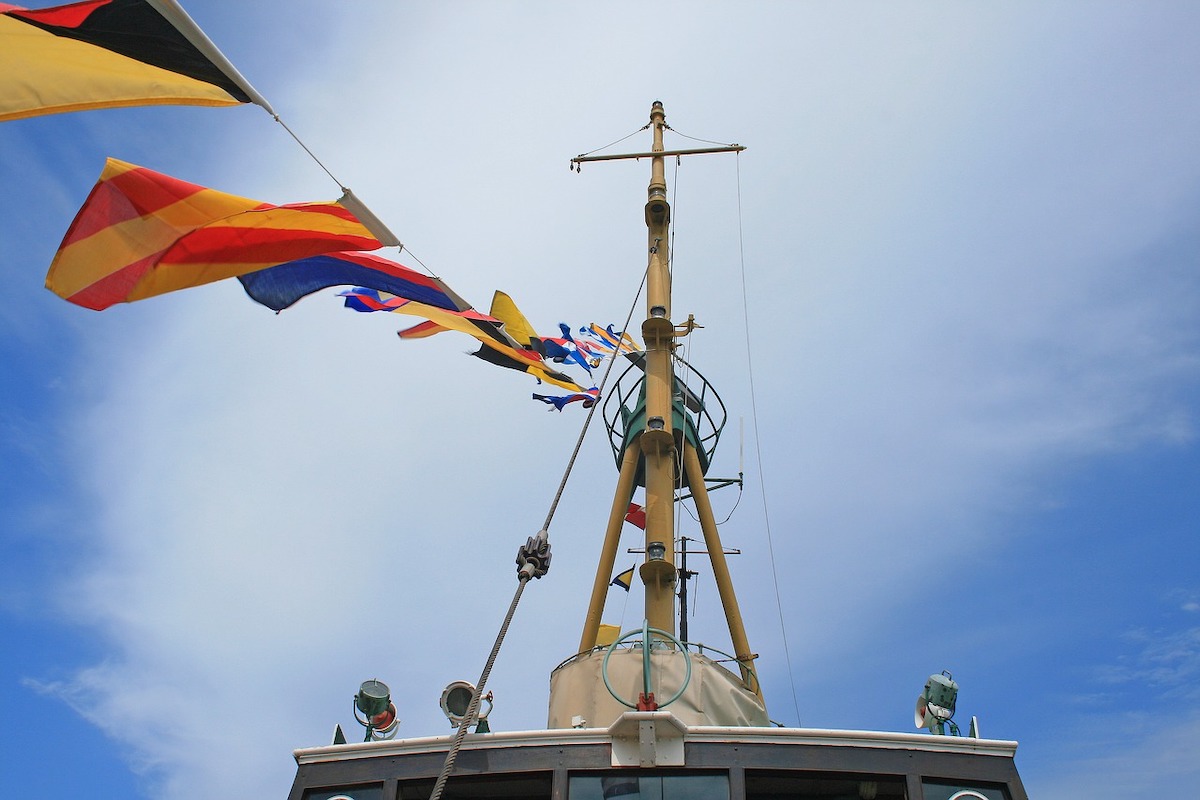
If you’re curious as to the deeper meaning behind these signals, here’s some nautical flags know-how.
1. Shapes and types are important.
Nautical flags mostly take the forms of squares, though you’ll also see pendants, which are triangular with a flat tip. You’ll additionally see what’s called substitutes (alternately called repeaters), which are triangles. Since this is a “flags 101” article, we’ll focus on the squares and pendants. They’re the ones you’re more likely to see in common boating situations.
2. Learn the letters and numbers.
There are 26 square nautical flags, each representing a different letter of the alphabet. More accurately, each represents the international code word connected to the letters of the alphabet, such as Alpha, Bravo, Charlie, Delta, and so on. In addition, there are 10 pendants for the numbers zero through nine. For the numbers 10 and larger, a boat would combine flags.
3. Colors are by choice.
The only colors you’ll find on nautical flags are black, blue, red, yellow, and white. These colors stand out quite well when seen with your own eyes on the horizon or through binoculars. Flags can be a solid color or a combination of colors, too.
4. Solo or combined, nautical flags convey meaning.
Depending on the intended message, boats fly one flag or up to seven flags in a row.
- For example, if you see the A (Alpha) flag , this means “diver down, keep clear.”
- If you see the W (Whiskey) flag , the boat has a medical emergency and needs help.
- The combination of the D (Delta) and V (Victor) flags , meanwhile, means “I’m maneuvering with difficulty and require assistance.”
- The J (Juliet) and L (Lima) flags mean “you’re running the risk of going aground.”
In fact, signals with two nautical flags typically mean some type of distress or maneuvering issue. Three or more flags can include pendants and denote things like points of the compass, geographical signals, names of ships, time and position, as well as latitude and longitude.
5. Flags are sometimes exclusive or secret language.
While boaters around the world use nautical flags to communicate common scenarios, particular situations call for their own language. Race committees combine flags to convey a race is four minutes from start, for example, or that a course has been shortened. The U.S. Navy groups together signals in ways known only to its personnel to communicate with its fellow ships.
Read Next: Basic Boating Etiquette
You Might Also Like:
- How to Navigate a Boat
- Boating Courses, Education & Training
- Safe Boating Guide
- Best Boating Apps: Navigation, Fishing, Weather & More
- The Ultimate Boat Buyer's Guide
Join Our Newsletter!
Get community news, buying bargains, and how-to guides at your fingertips.
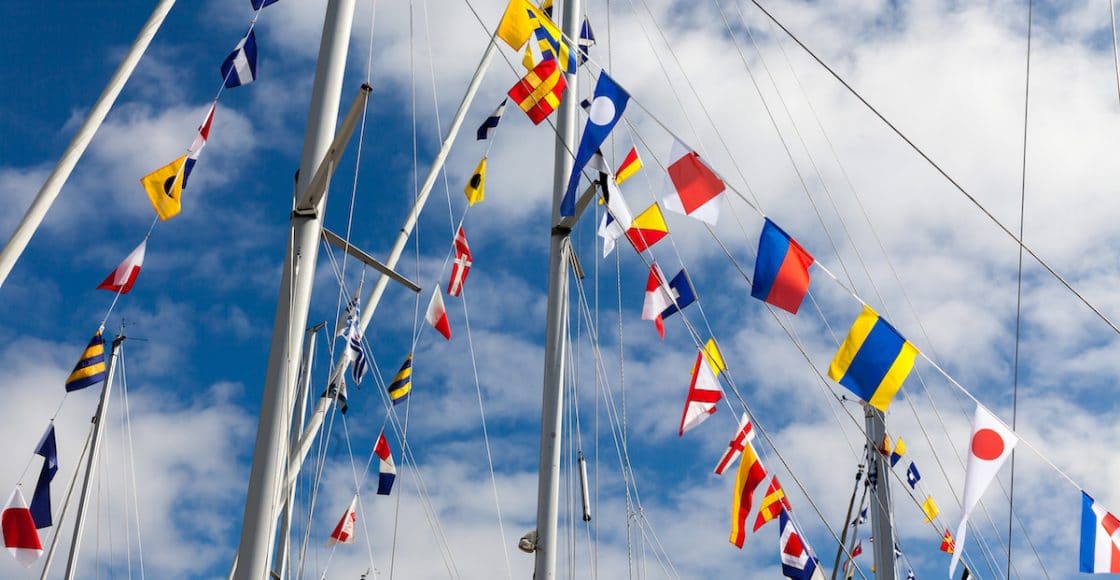
Understanding the Nautical Flags, Sailing Flags, & the Nautical Alphabet

Table of Contents
Last Updated on June 9, 2023 by Boatsetter Team
Just as the marine electronics and lights on a boat help you communicate with your fellow cruisers, nautical flags and sailing flags are a language of sorts, too. They help alert others to maneuvers you’re making, for example, or an emergency. In certain combinations, they warn of bad weather. It all depends upon which flag—or flags—you see.
Here’s how to make sense of the nautical flag alphabet. This way, you understand the situation at hand when you’re next out on the water.
Explore Powerboat & Sailboat Rentals Near You
6 Tips for Identifying Nautical Flags
1. pay attention to the flag’s shape..
Most nautical flags are squares. Additionally, you’ll find some resembling triangles but with flat tips—a.k.a. pendants. These two shapes are the most common.
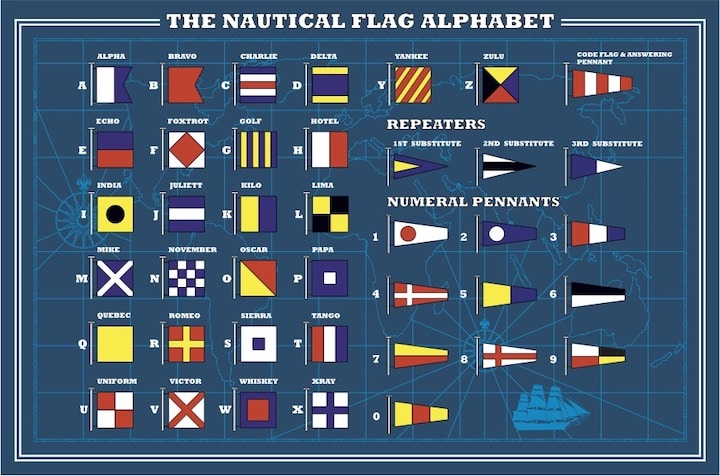
2. Learn the nautical flag alphabet.
Conveniently, for every letter of the alphabet, there’s an equivalent square nautical flag. Well, more accurately, each flag represents international code words like Alpha, Bravo, Charlie, etc., which correspond to alphabetical letters. The full list and their meanings:
- A – Alpha – diver down; keep clear
- B – Bravo – carrying dangerous cargo
- C – Charlie – affirmative (yes)
- D – Delta – keep clear, I am maneuvering with difficulty
- E – Echo – altering course to starboard
- F – Foxtrot – I am disabled, communicate with me
- G – Golf – I want a pilot
- H – Hotel – a pilot is onboard
- I – India – I am altering my course to port
- J – Juliet – vessel on fire, keep clear
- K – Kilo – I want to communicate with you
- L – Lima – stop your vessel instantly, I have something important to communicate
- M – Mike – my vessel is stopped and making no way through the water
- N – November – negative (no)
- O – Oscar – man overboard
- P – Papa – about to sail (when flown in port; at sea, fishing vessels use it to mean their nets are caught on an obstruction)
- Q – Quebec – I request free pratique (clearance to enter port due to no disease onboard)
- R – Romeo – reverse course
- S – Sierra – engines are going astern
- T – Tango – keep clear, I am engaged in trawling (if a fishing vessel; if a naval ship is flying this flag, it means do not pass ahead)
- U – Uniform – you are heading into danger
- V – Victor – I require assistance
- W – Whiskey – I require medical assistance
- X – X-ray – stop your intention
- Y – Yankee – I am dragging anchor
- Z – Zulu – I require a tug
3. Remember that the numbers on nautical flags have meanings, too.
When it comes to numbers, boaters use pendants. Ten different pendants represent the numbers zero through nine. A combination of flags denotes the numbers 10 and up.
4. Consider the color of the flag.
Nautical flags only use five colors:
Not coincidentally, each of these stands out against the sky, easily seen through binoculars or with the naked eye. You might see a solid-color flag or one with a combination of colors. For example, two red pendants means there’s a small-craft advisory.
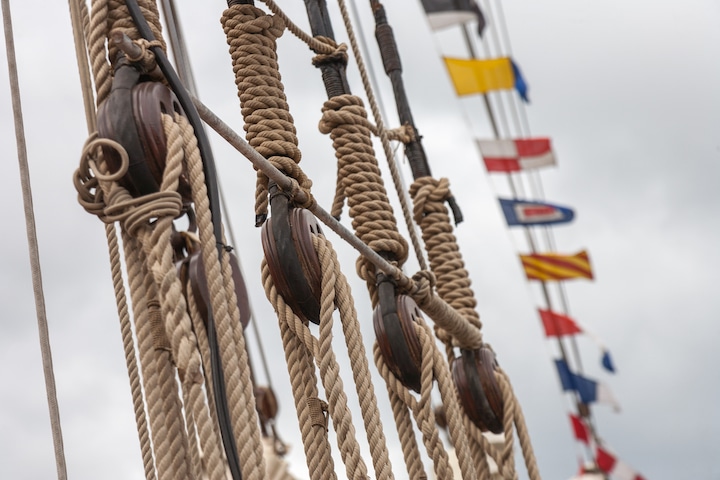
5. Tally the total.
Boats can fly up to seven flags in a row to convey certain messages.
- Solo flags are the previously mentioned international code words (Alpha for diver down, for instance).
- Two nautical flags flown together typically indicate distress or a maneuvering problem. A good example: Oscar and Whiskey flown together mean someone fell overboard and needs medical assistance.
- Three-flag signals can mean the points of the compass, among other things. Four-flag signals are ship names, while five are time and position. Six-flag signals indicate latitude and longitude, while seven mean longitude with more than 100 degrees.
6. Keep in mind that special languages exist.
Sometimes, the nautical flag alphabet is unique to certain situations. Regattas assign different meanings to a few flags, so that racers understand what’s happening. NATO and even the U.S. Navy do, too, with only their personnel knowing the meanings.
Ready to hit the water? Browse local boat rentals near you.

A journalist with more than 30 years’ experience, Diane M. Byrne is the owner of MegayachtNews.com, a daily website educating American superyacht owners, buyers, and their circles of influence about the leading builders, designers, cruising destinations, and more. She founded the website in 2007 as the first, and still the only, American-focused online media outlet exclusively covering this market. It features all-original content, for real stories of real interest.
Diane is additionally one of the most-sought-after journalists for expert editorial coverage and commentary about not only superyachts, but also general boating and yachting. Her byline appears in Boatsetter.com, DiscoverBoating.com, and the magazines Luxury Guide, Ocean, Yachting, and Yachts International.
Additionally, Diane is the Chair of the U.S. Superyacht Association, having been on the Board of Directors since 2015. Outside of yachting, she’s a trustee of Sempre Avanti, a non-profit resource supporting Italian and Italian-American individuals, businesses, and organizations in the United States and Italy.
Browse by experience

Explore articles

The 5 Biggest Boating Stories of 2023
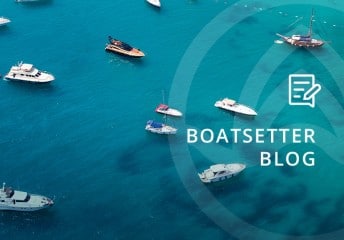
Boat Rental vs. Yacht Charter, Do You Know the Difference?
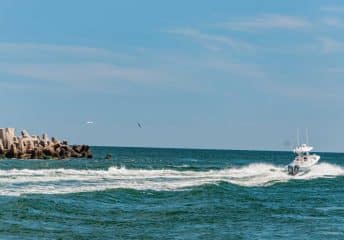
Fishing in New Jersey Guide
The 4 best lakes to boat on in dallas.

Sailboat Racing Flags and Signals
Are you ready to hit the open water and experience the exhilarating world of sailboat racing? Before you set sail, it’s crucial to understand the meaning behind the various flags and signals used during races . In this article, we’ll dive into the International Code of Signals, explore preparatory, course, protest, abandonment, penalty, safety, and emergency signals.
Get ready to navigate the racing scene with confidence and sail towards victory!
Key Takeaways:
- The International Code of Signals consists of 26 flags and 10 numeral pennants , which are used for safety and communication on the water.
- Preparatory flags and signals such as the ‘P’ flag, ‘I’ flag, ‘S’ flag, and ‘X’ flag are crucial for sailors to understand and respond to, as they indicate important instructions and changes in the race .
- Course and mark signals provide information about the direction to sail and the marks themselves, helping sailors navigate the racecourse effectively and make informed decisions.
- Protest flags and signals, including the red flag with a white cross, blue flag, yellow flag, and red flag, are important for ensuring fair competition and resolving disputes between boats.
Table of Contents
The International Code of Signals
You should learn the International Code of Signals, as it consists of 26 flags and 10 numeral pennants that can convey important messages while sailing. These signals are essential for maintaining safety and communication on the water. By familiarizing yourself with this code, you can ensure that you’re prepared for any situation that may arise while sailing.
The International Code of Signals is a universal system used by sailors around the world . Its simplicity and effectiveness make it a valuable tool for communication at sea. Each flag and pennant represents a specific message or instruction , allowing sailors to convey important information without relying on verbal communication.
Learning the International Code of Signals is particularly important for those who desire freedom on the water. By understanding and using these signals, you can communicate with other boats, request assistance, or inform others of potential dangers. This knowledge empowers you to navigate the open seas confidently and independently.
In addition to enhancing your safety, knowing the International Code of Signals also allows you to fully immerse yourself in the sailing community. It’s a language shared by sailors worldwide, connecting you to a global network of adventurers who share your love for the sea.
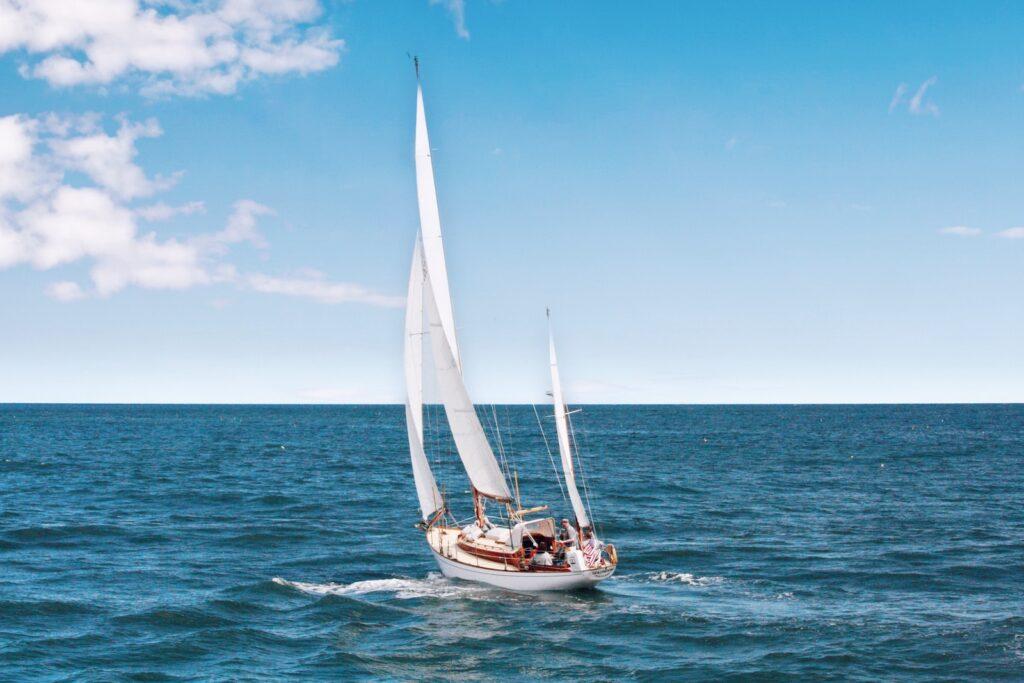
Preparatory Flags and Signals
Make sure to brush up on the meaning of the preparatory flags and signals before your next sail, as they can indicate important information about the race or event. These flags and signals are essential for every sailor who desires the freedom to compete in sailboat racing.
When you see the preparatory flag ‘P,’ it signals that the race is about to start, and you should be ready to go . Another important signal is the ‘I’ flag, which indicates a change in the starting line . Pay attention to this flag, as it could affect your strategy and give you a competitive advantage.
During the race, you may encounter the ‘S’ flag, which means you must take a penalty for a rule infringement . Don’t ignore this flag, as it could cost you valuable time and position. Additionally, the ‘X’ flag indicates that the race has been abandoned or postponed . If you see this flag, be prepared to follow the instructions given by the race committee.
Understanding and responding to these preparatory flags and signals is crucial for any sailor who values their freedom to compete in sailboat racing. So, take the time to familiarize yourself with them and be ready to navigate the racecourse with confidence and skill.
Course and Mark Signals
When approaching a mark, be sure to keep an eye out for the appropriate course and mark signals to navigate the racecourse effectively. These signals are crucial for your success as a sailor. Freedom is at the core of sailboat racing, and understanding these signals will give you the freedom to make informed decisions on the water.
As you approach a mark, look for the course signal displayed by the race committee . This signal indicates the direction you need to sail after rounding the mark. It could be a simple arrow pointing left or right, or it may consist of multiple arrows indicating a more complex course. Pay attention to this signal to ensure you take the correct path and stay on course.
In addition to the course signal, keep an eye out for mark signals . These signals provide important information about the mark itself. They can indicate a change in the mark’s position, a change in the rounding direction, or even a change in the mark itself . Understanding these signals will help you anticipate any changes in the racecourse and adjust your strategy accordingly.
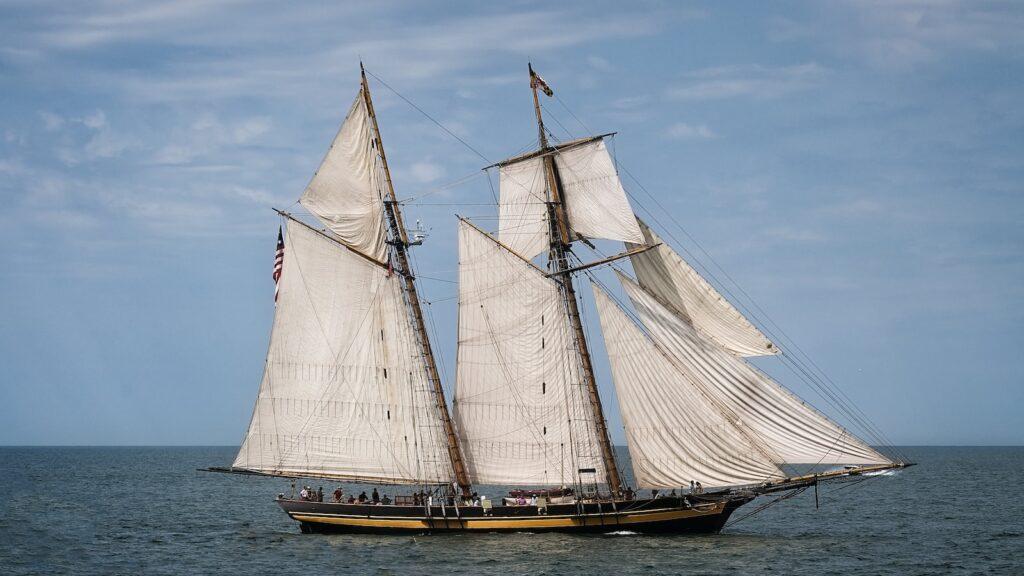
Protest Flags and Signals
When you see a protest flag in sailboat racing, it’s important to understand its meaning. The most common protest flag is a red flag with a white cross, indicating that a boat is protesting another boat for a rule violation.
If you find yourself in a protest situation, it’s crucial to know how to resolve it properly to ensure fair competition.
Meaning of Protest Flags
You should familiarize yourself with the meaning of protest flags before participating in sailboat racing. Understanding these flags is essential to ensure fair competition and maintain the freedom that racing represents.
Here are three important protest flags and their meanings:
- Blue Flag : This flag indicates that a boat intends to protest another boat for breaking a rule. It’s important to keep a close eye on this flag, as it signifies a potential dispute between competitors.
- Yellow Flag : When this flag is displayed, it means that a protest hearing is being held. This flag warns all participants to be cautious and respectful during the hearing process.
- Red Flag : The red flag is raised when a protest has been withdrawn. It signifies that the dispute has been resolved or abandoned.
Common Protest Signal
Don’t underestimate the significance of familiarizing yourself with the common protest signal during sailboat racing. It’s crucial to understand this signal as it can greatly impact your race and the freedom you desire on the open water.
When you see a boat raising a protest flag, typically a red flag, it means that they believe another boat has violated a racing rule. This signal signifies their intention to file a protest against the other boat’s actions.
As a sailor, knowing this signal allows you to be proactive in avoiding potential conflicts and ensuring fair competition. By being aware of the common protest signal, you can navigate the racecourse with confidence, knowing that you’re respecting the rules and upholding the freedom that sailboat racing represents.
Resolving Protest Situations
To effectively resolve protest situations during sailboat racing, it’s important that you remain calm and cooperate with the race officials. Remember, your freedom to enjoy the race depends on your ability to handle these situations with grace and respect.
Here are three key points to keep in mind:
- Communicate clearly: When presenting your protest, make sure your message is concise and easily understood. Use simple language and avoid any unnecessary aggression or hostility.
- Follow procedures: Familiarize yourself with the rules and regulations of the race. Understand the proper steps to take when filing a protest and be prepared to provide any evidence or witnesses that support your case.
- Be open to compromise: Sometimes, finding a middle ground is the best way to resolve a protest situation. Listen to the other party’s perspective and be willing to negotiate a solution that’s fair for everyone involved.
Abandonment Flags and Signals
Grab the binoculars and look for any abandonment flags or signals on nearby boats. As a sailor who desires freedom, you understand the importance of being aware of potential dangers on the water. Abandonment flags and signals are crucial in ensuring the safety of all sailors. These flags and signals indicate that a boat or its crew may require assistance or are in need of immediate rescue. By spotting these flags or signals, you can take action and provide the necessary help, ensuring that everyone can continue enjoying the freedom of sailing.
To help you better understand the various abandonment flags and signals, here is a table highlighting some of the most commonly used ones:
| Flag/Signal | Meaning | Emotional Response |
|---|---|---|
| Red flag | Boat is abandoned or crew is in distress | Concern, empathy |
| Orange smoke signal | Requesting immediate assistance | Urgency, alarm |
| Horn blasts | Distress signal | Attention, urgency |
Penalty Flags and Signals
Keep an eye out for any penalty flags or signals, as they can indicate rule violations and affect the outcome of the race. In sailboat racing, it’s crucial to understand the meaning behind these flags and signals to ensure fair competition and maintain the spirit of freedom on the water. Here are three key points to consider:
- Penalty flags: These flags are raised by race officials to indicate a rule violation by a boat. The flags come in different colors, such as yellow or blue, and are typically displayed alongside a number, representing the specific rule broken. Be vigilant in spotting these flags, as they can result in time penalties or disqualification.
- Signals from other boats: Pay attention to the actions of other boats around you. If a competitor raises a flag or makes a specific hand signal, it could be a warning that you have violated a rule. Keep an open mind and be ready to adjust your tactics to avoid penalties.
- Communication with race officials: If you have any doubts or concerns about a potential rule violation, don’t hesitate to contact the race committee. They’re there to ensure fairness and resolve any disputes that arise during the race. Maintain a respectful and open line of communication to uphold the principles of freedom and fair play.
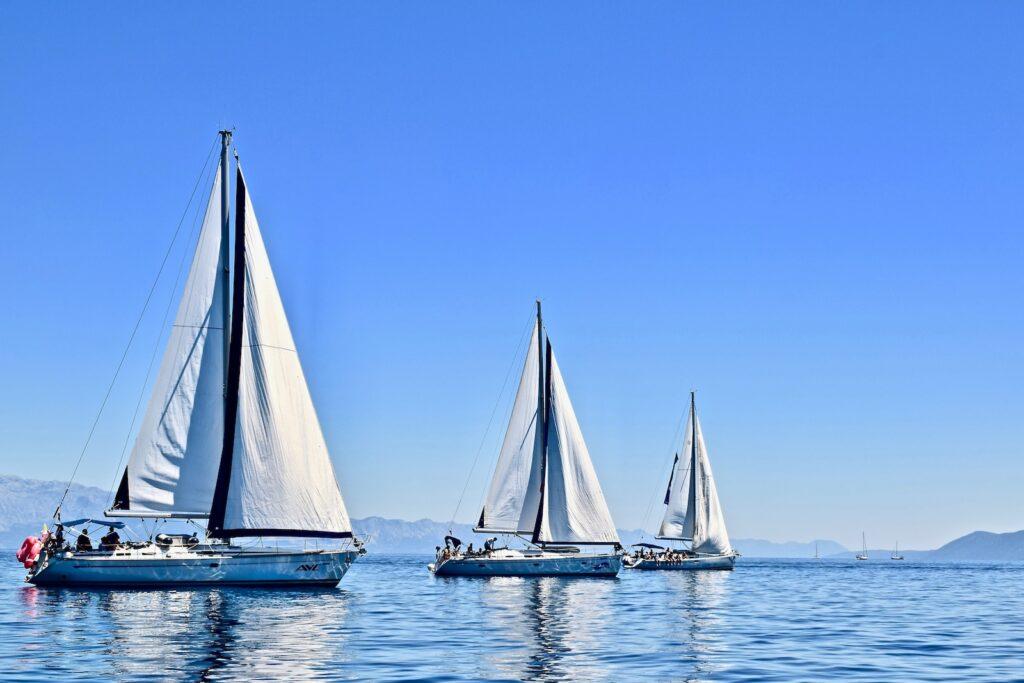
Safety and Emergency Signals
If you encounter any safety or emergency signals during the race, please follow the instructions provided and ensure the well-being of yourself and others. Your safety is of utmost importance, and it is crucial to understand the meaning behind these signals. To help you navigate the race course, here is a table outlining some common safety and emergency signals you may encounter:
| Signal | Meaning | Action Required |
|---|---|---|
| Red Flare | Emergency situation | Stop racing and await further instructions |
| Blue and White Checkered Flag | Abandon race | Return to the starting line |
| Orange Flag | Man overboard | Proceed with caution and assist if possible |
So, now you know the various sailboat racing flags and signals used in competitions. The International Code of Signals provides a standardized system for communication on the water.
From preparatory flags to protest flags, each signal plays a vital role in ensuring fair and safe races. Understanding these signals is crucial for all sailors and race officials.
By following the correct flags and signals, participants can navigate the racecourse effectively and respond appropriately to any emergencies or penalties that may arise.
Related posts:
Leave a Reply Cancel reply
Your email address will not be published. Required fields are marked *
Save my name, email, and website in this browser for the next time I comment.
FREE Shipping Available Orders $75+*
- Call us: 800-858-8776
- Sign In & Register
- Gift Certificates
- Recently Viewed
Your 2024 Guide to Nautical Flag Etiquette
Ever wonder why there are so many boat flags ? How do the sailors know which flag to put first and when? Nautical flag etiquette is an essential part of sailing. The seven most common types of boat flags are Skin Diver flags , Storm Warning flags , Coast Guard boat flags , US Jack flags , Maritime flags and Pennants, Yacht Ensign & Officer flags , and most importantly the International Code Signal flags .
Code signal flags and are frequently used by boats to send messages to other boats. They are made with a sequence of twenty-six square flags that represent a letter of the nautical alphabet. Ten numbered flags, one answering pendant, and three repeaters also form part of the nautical flag sequence.
As with most yesteryear traditions, the popularity of boat flags as a common communication tool is slowly reducing with the introduction of technology. This does not mean that we should discard this sacred tradition.
The world of nautical flags is broad, and we cannot possibly cover them all in this article. Navies, yachts and fishing boats have variations in the meaning of some flags.
While the need for nautical flags might be dwindling in the boating world, they are still pleasing to the eye. Learning when to use nautical flags and how to use them is a skill every sailor and thalassophile should have. Not only is it essential for safety reasons, but boat flags can also a lot of fun. Take a gander at our fun maritime flags and pennants !
Word of the Day: A thalassophile is someone that loves the sea!
This article will teach you the hows and whens of nautical flag etiquette. We will also provide you with a glossary of terms because, let's face it, some boating terms are pretty confusing even for a seasoned sailor.
So put your best sailor's cap on and join us on this great sea signal voyage.
What is Nautical Flag Etiquette?
Glossary of flag terms, flag courtesies.
As silly as it might seem, boat flag etiquette is crucial. In a worst-case scenario, it could mean the difference between life and death. Generally speaking, the nautical flag etiquette is a combination of years of maritime tradition and laws that help boats communicate messages to each other.
Different countries have varying legal requirements that should be observed for boats that enter and leave their waters or ports. So it is helpful to be mindful of sailing the vessel’s legal obligation for various countries. No one likes to pay a fine for something as simple as forgetting or putting up the wrong flag signal.
As we have stated before, the world of boating is vast and sometimes confusing. The terminology used is pretty unique. The key to understanding nautical etiquette is to know what everyone is talking about first.
Even professional sailors don't always get it right. So to help you brush up on your boating terms, we've put together this glossary with definitions. We hope this will help you to understand the nautical phrases that we will use in this article.
ABAFT - refers to the rear end or stern of a ship
AFT – means towards stern of the boat (the back of the boat)
ASTERN – it means to go towards the back of the boat
BOW - refers to the front of the ship
BUTT DIAMETER - is the width of the bottom of the flagpole.
CANTON - the rectangular part of a flag, usually at the top hoist corner of a flag, which occupies about a quarter of the total surface area of the flag
CLOSE UP - it means that the flags are now fully hoisted
COLORS - refers to the raising and taking down of the flags at 8:00 am and at sunset, respectively
COURTESY FLAG - is the national flag of the country that a boat is entering. Ex: Boats entering the United States would display an American flag as a courtesy flag.
DIP - means to lower a flag by turning it forward from an upright position to 45° or horizontal as a sign of deference or respect
ENSIGN - means a flag showing nationality of the boat, i.e. the country where the boat is registered. Ex:
- The Red Ensign can be flown by a merchant vessel
- The White Ensign can be flown by war or naval ships
- The Blue Ensign can be flown by public or government vessels
- The Civil Ensign is flown by civilian vessels
- The Yacht Ensign is flown by yachts and is typically the largest flag on board; the flag may be flown at stern staff
- The USPS ensign is flown by the United States Power Squadrons and is flown to signal that the boat is commanded by an active member of the USPS.
FLAG STAFF AT THE STERN - a pole at the stern/ back of the ship where the ship's country of registry flags is flown
FLY - refers to the length of the flag, measured from the heading to the fly end
GAFF - is a rig that extends from the flagpole that allows for more flags to be hoisted, which usually rises at an angle and represents the mast of a ship
HALYARD - rope or stainless steel cable used to hoist and lower flags
HOIST - the raising of flags
HOIST END - the edge of the flag that is closest to the flagpole
HOUSE FLAG - refers to the emblem that shows the company or commercial house that a merchant ship belongs to and also refers to a yacht owner's personal flag
INTERCO - stands for the International Code of Signals used in the maritime system
JACK - mean the additional national flags flown by warships (and certain other vessels) at the head of the shi
MASTHEAD - is the tallest part of a ship's mast or the lower section of a mast
NAUTICAL –refers to everything associated with maritime travel
NAUTICAL FLAGPOLE --refers to a flagpole with a yardarm and or gaff
PENNANT - is a triangular-shaped flag
PRATIQUE - refers to the license or permission to use a port from the host country
STARBOARD - is the right-hand side of the boat when you are facing the bow.
STARBOARD SPREADER - is the most forward part on the mast (if there is more than one) where the courtesy and q flags are flown
STEM – refers to the most forward part of the bow
STERN – refers to the back of the boat
STERN LINE – is the docking line that comes from the stern
TACK LINE - is the length of the halyard; it's used to separate the group of flags
UNDERWAY – means a vessel in motion
YARDARM - refers to the horizontally mounted and tapered pole attached to a flagpole to create a "t" or a cross
Now that we are familiar with some common terminology used in nautical language, let's move on to the order in which the flags must be arranged in terms of nautical flag etiquette rules.
This order is universal across the globe. We must follow the order to avoid confusing other ships. The flag with the highest honor should be flown at the highest point.
The order is as follows:
- Gaff (reserved for the national ensign/ country flag)
- Flagstaff at the stern
- Starboard yardarm (Halyard)
- Truck of mast (masthead)
- Port yardarm (Halyard)
First, we need to establish the system that governs these nautical flag rules. INTERCO is the International Code of Signals. The system is used worldwide to communicate nautical messages related to navigation, safety, and maritime.
Signal flags like the ones we are discussing in this article form part of INTERCO's signals. The other signals include radiotelegraphs or radiotelephones, ALDIS lamps, hand signals and some sound signals to name a few.
Knowing and understanding the basics of the INTERCO signaling system is extremely important for anyone interested in sailing. Whether privately or otherwise.
The National Ensign/Flag
Let's talk about nautical etiquette rules that apply for the most critical flag signal, the national ensign.
The U.S. national ensign is the preferred flag for all U.S. vessels. This ensign is also known as the “50-star of “Old Glory.” This is also the preferred ensign for yachts, especially when sailing in international or foreign waters.
Great honor is given to the national flag of the country in which the ship is registered. On the order of positioning for the flags, the national ensign is given that most senior position; the gaff. If your boat does not have a gaff, then you should fly the ensign from the flagstaff at your boat's stern.
The second rule is that you can fly no other flag above the national ensign on the same halyard. Additionally, the Jack and the National Ensign should not be hoisted together. The Jack is only hoisted when the ship is at anchor or made fast to the shore or to buoy, never when the ship is underway, when the last line is cast off, and when the anchor is aweigh. We do not recommend hoisting the Jack for recreational purposes.
The scenarios where a national ensign should be flown include:
- When dressing the ship
- When occupying foreign waters during the daylight hours
- When moving along a foreign port or a combat ship (man of war)
The Courtesy Flag
Flying the courtesy flag is a centuries-old tradition that is still relevant in these modern times. The act of flying a foreign nation's flag as your ship passes through or enters its waters is not only a sign of respect, it is an essential etiquette to observe. While there is no legal requirement to fly a courtesy flag, it is a polite custom to which you should adhere.
The only legal requirement for vessels in foreign water is to fly the red ensign flag.
Where does the courtesy flag fly? As per tradition, the courtesy flag is flown at the starboard spreader. If your boat has more than one mast, you must fly the courtesy flag from the forward most mast. The courtesy flag is tied and hoisted after the authorities have granted your vessel clearance to enter their space.
Key rules for courtesy flag etiquette include:
- Never fly the national ensign and the courtesy flag on the same mast because that will be interpreted as a sign of you are challenging the foreign nation's authority
- Never fly a courtesy flag that is in terrible condition; this is a sign of disrespect
- If you have guests on your boat that are of another nationality, then you should also fly their national flags as a courtesy, but never on the same mast
- When you return to your home country, always take down the foreign country's flag
Additional courtesy flag etiquette includes:
- If your boat is mastless, then the courtesy flag can replace any flag which is normally flown at the bow of the boat
- If your boat has a mast with a spreader, the courtesy flag is flown at the starboard spreader
However, you must keep in mind that these rules or traditions vary from one country to another, so always make sure that you look for the correct information.
Nautical Flag Etiquette Entering a Foreign Port
The Q flag is the first flag that you must raise when entering foreign waters or a foreign port. It signals to the port authorities that your ship is healthy and you require free practice.
We always fly the Q flag in international waters before customs clears you for entry. After clearing, you then replace the Q flag with the courtesy flag. You often fly the Q flag on the starboard yardarm.
Dressing the Ship
Certain occasions require that your vessel be decked up with all the flags that it can hold. We call this dressing the ship.
It is reserved for special occasions such as public holidays or when the ship is beginning its maiden or last voyage. Dressing the ship is only done when the ship is not underway.
The ship's full splendor will be on display, so this is the time to have fun. The dressing begins at 08.00 am at anchor unless it is the ship's maiden or last voyage, then the dressing can occur at sea.
The national ensign is first. All the other flags will follow, lining up from the waterline forward to the waterline after using the stem or bowsprit end and the masthead.
We have barely scratched the surface of all the rules and customs you need to follow to observe proper nautical flag etiquette. However, we hope that we have simplified some of the most important customs in maritime tradition. Hopefully, the next time you are on a boat, you will understand the meaning of the signals and flags better. Happy sailing!
Recent Posts
The small business guide to iso certification.
Although we focus on selling flags rather than pursuing these certifications ourselves, as ISO fl
Understanding the US Flag Code and Specialty Flags: A Customer's Guide
The flag of the United States of America is considered a living object, and its treatment reflects o
- Build A Boat
- Find A Dealer

- Boating Condition Flags and Their Meanings

When you’re out on the water, you’ll want to pay close attention to boating condition flags. These vibrant signals fluttering in the wind hold crucial information that can make a world of difference in ensuring your safety and enhancing your overall boating experience. But what exactly are boating condition flags and why should you care?
Boating condition flags are visual indicators that communicate vital messages to boaters, including potential hazards, restricted areas or favorable conditions. They serve as a universal language on the water, allowing boaters to understand and respond appropriately to changing situations.
General Flag Etiquette
When you follow these general flag etiquette guidelines , you’ll contribute to a safer and more enjoyable boating experience for everyone. Boating condition flags serve as a universal language on the water, enabling effective communication and helping to prevent accidents or misunderstandings.
Here are some tips and pieces of general flag etiquette you should know:
- Awareness is vital: Watch for flags displayed on other vessels, docks or shore-based facilities.
- Recognize and respect: Once you spot a flag, understand its meaning. Each flag represents a specific message or condition.
- Follow flag authority: Various authorities may display flags, such as marine law enforcement agencies, harbor masters or event organizers. Respect and comply with the instructions conveyed by these boating flags, as they are there for your safety and the safety of others.
- Communication is critical: If you’re hosting an event or activity on the water, clearly communicate the meaning of any flags you display to participants and other boaters.
- Display flags correctly: When flying flags on your vessel, ensure they are visible and recognizable from a distance. Flags should be securely attached and positioned to make them visible and easily identified by others.
- Know the rules and regulations: Different regions or waterways may have specific rules and regulations regarding boating condition flags.
- Act responsibly: Understanding flag signals is not enough — you must also respond appropriately. If you encounter a flag indicating potential hazards or restricted areas, navigate cautiously or follow any instructions given by the flag authority. Similarly, if you come across a flag indicating medical assistance or a vessel requesting communication, be prepared to lend a helping hand or provide the requested information if you can do so safely.
Common Boating Condition Flags and Their Meanings
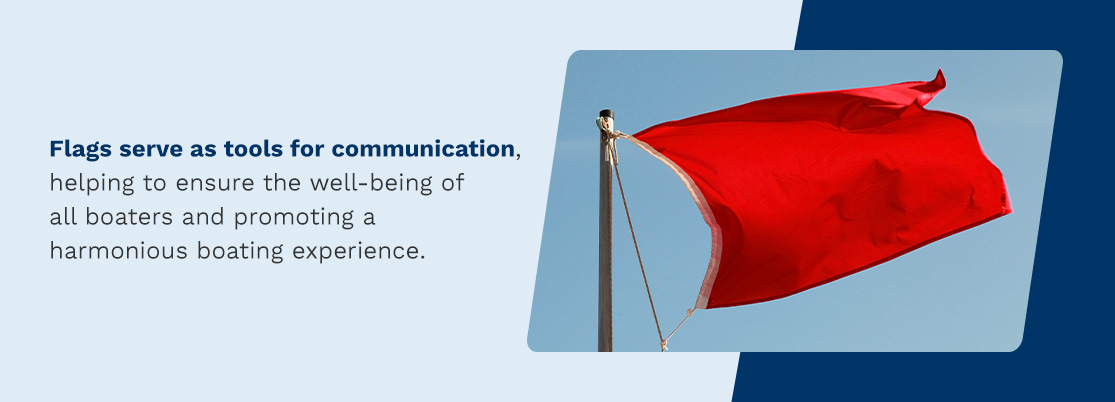
Flags serve as tools for communication, helping to ensure the well-being of all boaters and promoting a harmonious boating experience. They come in various boating flag colors , each carrying a specific meaning that communicates essential information to boaters:
- Red flag: The red flag signifies potential hazards or restrictions. It alerts boaters to exercise caution and be aware of dangers in the vicinity. Proceed with vigilance. The flag indicates conditions that may pose risks, such as strong currents, submerged objects or shallow waters.
- Yellow flag: This indicates caution or restricted boating conditions. It serves as a warning to boaters to approach the area carefully and be prepared for potential hazards. Slow down and be extra cautious.
- Green flag: When you see a green flag waving proudly, you can relax and enjoy your boating adventure with peace of mind. It signifies favorable conditions for safe and unrestricted navigation.
- Black flag: It serves as an alert to take immediate action to ensure safety and seek shelter if necessary. Be prepared for inclement weather like strong winds , thunderstorms or rough seas. Take appropriate measures to protect yourself and your vessel.
- Orange flag: When you spot orange boating flags, be aware that activities such as races, regattas or other organized events may occur in the vicinity. Respect any instructions or rules associated with these events.
Additional Boating Condition Flags
In addition to the common boating condition flags we discussed earlier, there are several additional flags you may come across during your boating escapades. While you may not encounter these flags as often, understanding these boating flags and their meanings helps ensure you stay prepared.
Here are the additional flags you might see:
- Blue flag: If you encounter a vessel displaying a blue flag, be prepared to provide any necessary aid or contact emergency services.
- White flag: Be attentive and ready to respond if you see a white flag raised on a nearby vessel. It may indicate that the boat needs information, assistance or coordination regarding navigation, docking or other relevant matters.
- Checkered flag: The checkered flag signifies the presence of water sports or races. Maintain a safe distance and avoid interfering with the participants.
Recognizing and Responding to Boating Condition Flags
Understanding boating condition flags is only half the equation. Equally important is the ability to recognize and respond to these flags appropriately. Keep a keen eye on your surroundings, including other vessels, docks and shore-based facilities. By identifying and responding appropriately to boating condition flags, you become an active participant in promoting safety and effective communication on the water.
Study these tips for recognizing and responding to boating condition flags:
- Understand flag meanings: Study their colors, shapes and symbols to identify their messages quickly.
- Follow instructions and warnings: When you encounter a flag signaling potential hazards, restrictions or weather warnings , heed the instructions provided. Adjust your course, speed or activities accordingly to ensure your safety and that of others.
- Maintain effective communication: If you need to communicate with other boaters, use appropriate signals or methods as indicated by the flags. For example, if a vessel displays a white flag requesting communication, be responsive and establish contact through radio, horn signals or other accepted means.
- Adhere to local and international regulations: Understand and follow the rules and regulations specific to the waterway or region you are navigating. Different areas may have variations in flag usage or additional local flags, such as international maritime signals, each with specific boating flag meanings.
- Be prepared to assist: If you come across a flag signaling a vessel in distress or requesting medical assistance, be ready to provide aid if you are capable and safe.
Build Your Boat With Formula Boats
You can confidently navigate and contribute to a safe boating community by deciphering flag meanings, following flag etiquette and responding appropriately. As you embark on your boating adventures, consider building your boat with Formula Boats. With over 65 years of marine manufacturing excellence, Formula Boats is a trusted name in the industry.
Owned and managed by the Porter family since 1976, we are known for visionary design, superior execution and unwavering commitment to customer satisfaction. From our smallest Bowrider to the remarkable 500 SSC, each Formula boat is crafted with premium materials and meticulous attention to detail.
Experience the Formula difference and create memories on the water that will last a lifetime. To start building your dream boat or to learn more about Formula’s offerings, don’t hesitate to contact us today.
Get ready to embark on your boating journey with Formula , where excellence meets adventure.
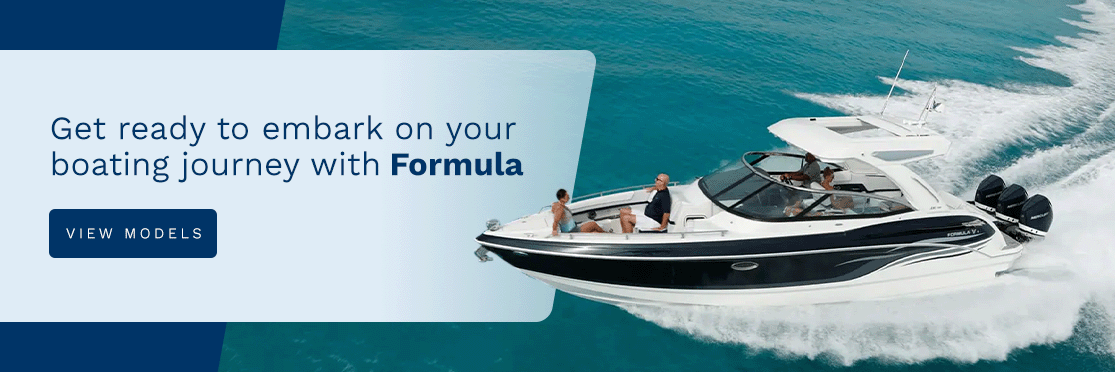
Contact Dealer
This site is protected by reCAPTCHA and the Google Privacy Policy and Terms of Service apply

Set Sail to Victory: Mastering Sailboat Racing Flags and Signals
Sailboat racing is a thrilling and challenging sport that requires skill, strategy, and knowledge of sailing rules and regulations. One of the essential components of sailboat racing is the use of flags and signals to communicate important information to the sailors.
Sailboat racing flags and signals are a standardized system used to convey messages about the course, starting times, penalties, and other critical information. In this article, we will explore the various sailboat racing flags and signals and their importance in the sport.
The Importance of Sailboat Racing Flags and Signals
Sailboat racing flags and signals are a set of visual cues used to communicate important information to sailors during a race. These signals can indicate the start and end of a race, changes in wind direction, or other important information that can affect a sailor’s strategy.
Understanding these signals is critical for any sailor who wants to compete in a sailboat race. Some common sailboat racing flags and signals include the “preparatory” flag, which indicates the start of the race is imminent, and the “postponement” flag, which indicates a delay in the start of the race.
Sailboat racing flags and signals are essential to the smooth and safe conduct of sailboat races. Without these flags and signals, sailors would be unable to navigate the race course safely or understand the starting times, course changes, or penalties.
Flags and signals provide a standardized system of communication that ensures that all sailors have the same information at the same time. This, in turn, promotes fair competition and ensures that all sailors have an equal opportunity to win.
The Basic Sailboat Racing Flags and Signals
The World Sailing ( WS ) is the world governing body for the sport of sailing (until 14 November 2015 named as International Sailing Federation or ISAF) has established a standardized system of sailboat racing flags and signals that are used worldwide. These flags and signals communicate essential information about the race, such as the starting times , course changes , penalties , and finish line . Below are the most common sailboat racing flags and signals:
The Preparatory Signal
The preparatory signal is the first signal made before the start of a sailboat race. This signal indicates that the race is about to start and that the boats should be prepared to start racing. The preparatory signal is usually made 5 to 10 minutes before the start of the race, depending on the size and type of race.
During the preparatory signal, the race committee displays the preparatory flag, which is a solid white flag with a blue horizontal stripe. The preparatory flag is displayed until the starting signal is made. Boats that cross the starting line before the starting signal is made are considered to have started early and may be penalized.
The Starting Signal
The starting signal is the second signal made in a sailboat race. This signal indicates that the race has officially started, and the boats can begin racing. The starting signal is usually made immediately after the preparatory signal, although there may be a delay if conditions are not suitable for racing.
The starting signal is made using the starting gun or horn. Boats must cross the starting line after the starting signal is made, or they will be considered to have started late and may lose valuable time.
The General Recall Signal
The general recall signal is made when the race committee determines that the starting sequence has not been fair or equal for all boats. This signal indicates that the race will be restarted.
During the general recall signal, the race committee displays the first substitute flag, which is a blue and white flag with a blue square in the center. Boats must return to the starting line and prepare to start again.
The Individual Recall Signal
The individual recall signal is made when a specific boat is identified as starting early. This signal indicates that the identified boat must return to the starting line and start again.
During the individual recall signal, the race committee displays the X flag, which is a black flag with a white square in the center. The identified boat must return to the starting line and start again after all other boats have started.
The Postponement Signal
The postponement signal is made when conditions are not suitable for racing. This signal indicates that the start of the race will be delayed until conditions improve.
During the postponement signal, the race committee displays the AP flag, which is a solid blue flag. Boats must return to the starting area and wait for further instructions.
The Abandonment Signal
The abandonment signal is made when conditions become too dangerous for racing. This signal indicates that the race will be abandoned, and all boats must return to shore.
During the abandonment signal, the race committee displays the N flag, which is a solid black flag. Boats must stop racing and return to shore immediately.
The Shortened Course Signal
The shortened course signal is made when conditions are not suitable for completing the full race course. This signal indicates that the race course will be shortened to ensure the safety of the boats and sailors.
During the shortened course signal, the race committee displays the S flag, which is a solid white flag with a blue square in the center. Boats must complete the shortened course and cross the finish line.
The Finish Signal
The finish signal is the final signal made in a sailboat race. This signal indicates that the race is over, and the boats have completed the race course. The finish signal is usually made when the boats cross the finish line.
During the finish signal, the race committee displays the finishing flag, which is a solid white flag with a blue vertical stripe. Boats must cross the finish line and complete the race. The boats are then ranked based on the order in
Additional Sailboat Racing Flags and Signals
In addition to the basic sailboat racing flags and signals, there are other flags and signals used in sailboat racing. These flags and signals communicate additional information about the race, such as penalties and rule enforcement. Below are some additional sailboat racing flags and signals:
The Penalty System
In sailboat racing, the penalty system is an important mechanism to ensure fair play and discourage cheating. The penalty system involves the use of penalty turns, which is a requirement for a boat to make a 360-degree turn as a result of committing a rule violation. The penalty turns must be completed as soon as possible, and failure to do so will result in further penalties.
The penalty system is signaled by the display of the “yellow flag” by the race committee boat. This flag is accompanied by a horn blast, which signifies that a penalty has been given to a boat. If a boat receives a penalty, it must complete the penalty turns as soon as possible.
The Black Flag Rule
The black flag rule is a sailing rule that is used to discourage boats from starting too early. Under this rule, if a boat is over the starting line when the starting signal is given, it is disqualified from the race.
The black flag is signaled by displaying a black flag with a white square in the middle. This flag is displayed with the one-minute signal before the start of the race. If a boat is over the starting line when the race starts, and the black flag is displayed, the boat is disqualified.
The Blue Flag Rule
The blue flag rule is used to indicate that a boat is in danger and requires assistance. The blue flag is displayed by a boat that requires assistance, and this signal must be acknowledged by other boats in the race.
The blue flag is displayed by a boat in distress or requiring assistance, and other boats must immediately make way for the distressed boat. If a boat fails to acknowledge the blue flag signal, it may be subject to penalties.
The Red Flag Rule
The red flag rule is used to s ignal that a race has been stopped due to an emergency situation . The red flag is displayed by the race committee boat, and all boats must immediately stop racing.
If the red flag is displayed, all boats must immediately stop racing and proceed to the designated area. The race will be restarted once the emergency situation has been resolved.
Sailboat racing flags and signals are a crucial part of the sport of sailboat racing. They provide a standardized system of communication that ensures fair competition and safe racing. Understanding these flags and signals is essential for all sailors who want to compete in sailboat racing.

What happens if a boat does not follow the sailboat racing flags and signals?
If a boat does not follow the sailboat racing flags and signals, it may be penalized or disqualified from the race.
Are sailboat racing flags and signals the same worldwide?
Yes, sailboat racing flags and signals are standardized worldwide by the International Sailing Federation (ISAF).
What is the penalty for starting early in sailboat racing?
The penalty for starting early in sailboat racing is usually a 360-degree turn penalty.
How are safety rules enforced in sailboat racing?
Safety rules are enforced in sailboat racing using the red flag rule. If a boat is identified as posing a safety risk, it will be disqualified from the race.
Can sailboat racing flags and signals change during a race?
Yes, sailboat racing flags and signals can change during a race due to weather conditions or other safety concerns.
- Recent Posts
- The Role of Cargo Ships in Global Trade – August 22, 2024
- Report: Yang Ming’s YM Mobility Explosion at Ningbo-Zhoushan Port – August 9, 2024
- Understanding Drillships: Types, Key Features and Advancements – August 1, 2024
About the author
I worked as an officer in the deck department on various types of vessels, including oil and chemical tankers, LPG carriers, and even reefer and TSHD in the early years. Currently employed as Marine Surveyor carrying cargo, draft, bunker, and warranty survey.
Latest posts

The Role of Cargo Ships in Global Trade
Contents show Volume of Goods Transported by Sea Key Global Trade Routes Economic Impact of Maritime Shipping Types of Cargo Commonly Transported Environmental Considerations Conclusion Cargo ships are the lifeline […]

What Are AGVs? Automation Becoming Increasingly Common in Seaports
What are AGVs? Automated guided vehicles can minimize the troubles of manual operations and enhance seaport operations.
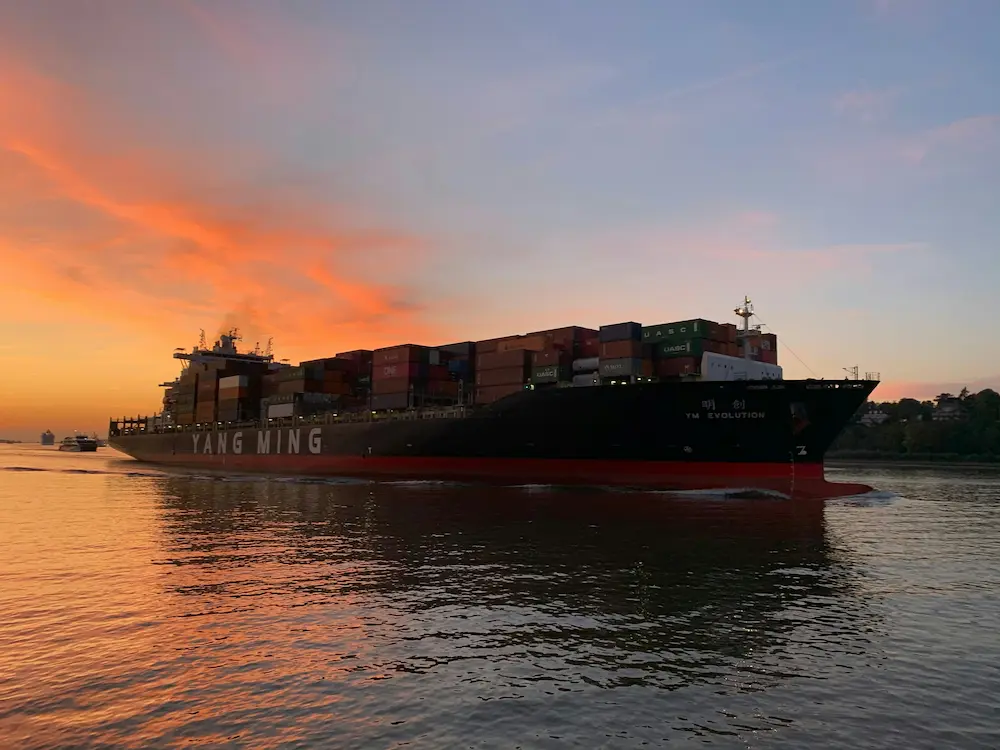
Report: Yang Ming’s YM Mobility Explosion at Ningbo-Zhoushan Port
A massive explosion occurred on the container ship YM Mobility while it was berthed at the Ningbo-Zhoushan Port in China
- Types of Sailboats
- Parts of a Sailboat
- Cruising Boats
- Small Sailboats
- Design Basics
- Sailboats under 30'
- Sailboats 30'-35
- Sailboats 35'-40'
- Sailboats 40'-45'
- Sailboats 45'-50'
- Sailboats 50'-55'
- Sailboats over 55'
- Masts & Spars
- Knots, Bends & Hitches
- The 12v Energy Equation
- Electronics & Instrumentation
- Build Your Own Boat
- Buying a Used Boat
- Choosing Accessories
- Living on a Boat
- Cruising Offshore
- Sailing in the Caribbean
- Anchoring Skills
- Sailing Authors & Their Writings
- Mary's Journal
- Nautical Terms
- Cruising Sailboats for Sale
- List your Boat for Sale Here!
- Used Sailing Equipment for Sale
- Sell Your Unwanted Gear
- Sailing eBooks: Download them here!
- Your Sailboats
- Your Sailing Stories
- Your Fishing Stories
- Advertising
- What's New?
- Chartering a Sailboat
- Sailboat Flag Etiquette
Sailboat Flag Etiquette: What You Need to Know
Sailboat flag etiquette is steeped in maritime tradition and enshrined in law. If you're new to the world of sailing, you may have wondered about the various flags that you see flying on other sailboats or that you are expected to fly on your own. What do they mean? How should they be displayed? What are the rules and traditions that govern them?
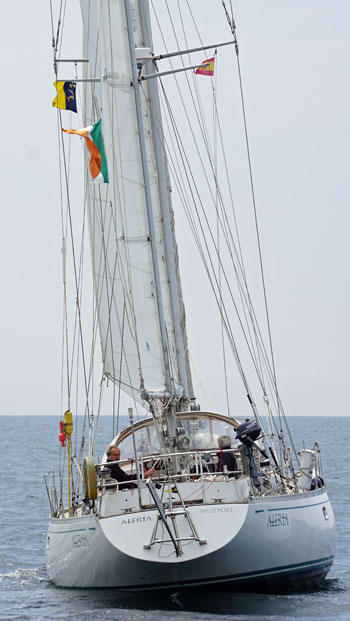
An experienced sailboat skipper will know that flag etiquette is a way of showing respect, courtesy and recognition to other vessels, countries and organizations.
It also helps you communicate important information, such as your nationality, your club affiliation, your intentions or your distress.
For the less experienced we'll explain the basics of sailboat flag etiquette and how it should be applied in practice:
- The types of flags that you can fly on your boat;
- The sizes and positions of the flags;
- The occasions and situations when you should fly certain flags;
- The common mistakes and pitfalls to avoid when flying flags.
The skipper of the Bowman 57 staysail ketch shown here is correctly flying a burgee (the Flying Fish burgee of the Ocean Cruising Club ) from the port spreader, and a courtesy ensign (of Spain in this case) from the starboard spreader.
The ensign, in this case that of the Republic of Ireland, is flown from a flag halyard from the mizzen mast to the end of the mizzon boom. Alternatively the ensign could be flown from a staff attached to the taffrail.
The Types of Flags
There are many types of flags that you can fly on your boat, but the most common ones are:
- The ensign: This is the flag that shows the country of registry of your boat and indicates its nationality. It is usually flown at the stern of the boat, as close as possible to the waterline. It is the most senior position for a flag on a boat and it should always be larger than any other flag. A UK flagged boat (sail or power) must wear the national maritime flag, the Red Ensign, unless entitled to wear a special ensign.
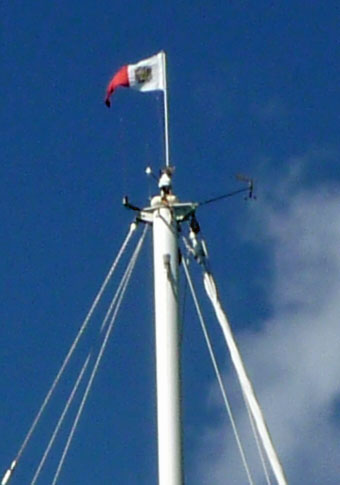
- The burgee: This is the flag that shows the yacht club or association that you belong to. It is usually flown at the main masthead of the boat above any other flag, but can be flown from the port spreader unless otherwise stipulated under a special warrant.
- The courtesy flag: This is the flag that shows the national flag of the country that you are visiting or whose waters you are sailing in. It is a sign of respect and goodwill to the host country and it should be flown at the starboard spreader. It should be hoisted as soon as you enter foreign waters and lowered as soon as you leave them.
- The Q flag: This is a yellow flag that indicates that you are requesting clearance from the local authorities when entering a foreign port. It is also flown at the starboard spreader of the boat, below the courtesy flag if there is one. It should be hoisted before you enter the port and lowered after you have been cleared.
- The signal flags: These are flags that have specific meanings in the International Code of Signals. They can be used to spell out messages or to convey information such as your position, your course, your speed, your intentions or your distress. They can be flown individually or in combinations at various locations on the boat.
- The private signal: This is a personal or family flag that has no official meaning or recognition. It can be flown at the port spreader of the boat, below any other flag. It is optional and purely decorative.
The Sizes and Positions of the Flags
The sizes and positions of the flags on your boat are important for both aesthetic and practical reasons. They should be proportionate to your boat size, visible from a distance and clear from any obstruction.
The general rules for sizing and positioning flags are:
- The ensign should be one inch on the fly (the length) for every foot of overall length of your boat. It should be flown on the stern staff or on a gaff if there is one.
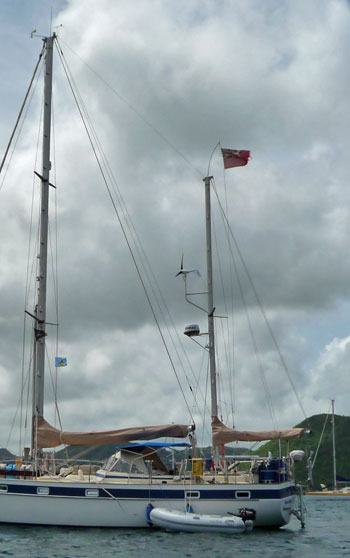
- The burgee should be half an inch on the fly for every foot of overall length of your sailboat or five-eighths of an inch for every foot of overall length of your powerboat. It should be flown at the main masthead or on a pigstick (a vertical extension) if there is one.
- The courtesy flag should be the same size as the burgee or slightly smaller. It should be flown at the starboard spreader, preferably on its own halyard.
- The Q flag should be the same size as the courtesy flag or slightly smaller. It should be flown at the starboard spreader, below the courtesy flag if there is one, on its own halyard.
- The signal flags should be sized according to their function and meaning. They can be flown individually or in combinations at various locations on the boat, such as the masthead, the yardarm, the bow or the stern of the boat.
- The private signal should be the same size as the burgee or slightly smaller. It should be flown at the port spreader, below any other flag, on its own halyard.
The Occasions and Situations When You Should Fly Certain Flags
The occasions and situations when you should fly certain flags on your boat depend on where you are, what you are doing and who you are with. Some flags are mandatory, some are optional and some are forbidden.
The general rules for flying flags are:
- You must fly your ensign at all times in daylight, especially when near to or in sight of land or another boat. You must also fly your ensign when entering or leaving a foreign port and on demand. You can fly your ensign at night if you wish, but it is not required.
- You can fly your burgee at any time, but it is customary to hoist it at 0800 and lower it at sunset. You can also fly your burgee at night if you wish, but it is not required.
- You must fly the courtesy flag of the country that you are visiting or whose waters you are sailing in as soon as you enter their jurisdiction and until you leave it. You must also fly the Q flag when entering a foreign port until you have been cleared by the local authorities. You can lower the Q flag after you have been cleared, but you should keep the courtesy flag until you leave the port or the country.
- You can fly signal flags whenever you need to communicate with other boats or shore stations using the International Code of Signals. You can also fly signal flags for decorative purposes, such as dressing your boat for a special occasion, but you should avoid using flags that have specific meanings or that could cause confusion.
- You can fly your private signal whenever you want, but it has no official significance or recognition. It is purely a personal or family emblem.
The Common Mistakes and Pitfalls to Avoid When Flying Flags
Flying flags on your boat can be fun and rewarding, but it can also be tricky and challenging. There are some common mistakes and pitfalls that you should avoid when flying flags, such as:
- Flying an incorrect, damaged, wrongly sized or otherwise invalid ensign. This is a breach of law and etiquette and could lead to fines or penalties.
- Flying a special ensign without being entitled to do so. This is a privilege granted by a warrant from the Admiralty or by an Act of Parliament and it requires certain conditions to be met.
- Flying a burgee that does not match your ensign or that is higher than your ensign. This is a sign of disrespect and ignorance and could offend other boats or authorities.
- Flying more than one burgee at a time. This is considered sloppy and excessive and could imply that you are showing off or indecisive.
- Flying a courtesy flag that is larger than your burgee or that is above your burgee on the same halyard. This is a sign of subservience and inferiority and could insult your own country or club.
- Flying a Q flag when you have already been cleared or when you are leaving a port. This is unnecessary and confusing and could cause delays or misunderstandings.
- Flying signal flags that have specific meanings or that could cause confusion for decorative purposes. This is irresponsible and dangerous and could lead to accidents or incidents.
- Flying a private signal that resembles an official flag or that has an offensive meaning. This is misleading and rude and could provoke anger or hostility.
- And you should never, ever, fly a skull-and-crossbones flag. There is nothing amusing or glamorous about pirates.
Sailboat Flag Etiquette: A Few FAQs...
Why do some British sailboats fly a White or Blue Ensign rather than the traditional Red Ensign?
Some British sailboats fly a white or blue ensign because they belong to certain yacht clubs or organisations that have special permission to use these ensigns.
The white ensign is a variation of the national flag that is normally used by the Royal Navy, but it can also be worn by yachts owned by members of the Royal Yacht Squadron , which is a privileged yacht club with a long history and close ties to the monarchy.
The blue ensign is another variation of the national flag that is normally used by government vessels, but it can also be worn by yachts that belong to one of the 32 yacht clubs or associations that have a warrant from the Admiralty or the relevant authority to use the undefaced blue ensign.
Additionally, some yachts can wear a blue ensign defaced with the badge of their club or association, if they have a warrant for that as well. There are 57 yacht clubs or associations that have this privilege.
These special or privileged ensigns are considered a mark of distinction and honour, and they should only be flown with proper authorisation and following the rules and regulations of wearing them.
What is the difference between an ensign and a burgee?
An ensign is a flag that shows the nationality of the vessel and must be worn at the stern or as close to it as possible. A burgee is a flag that shows the membership of a yacht club or sailing association and can be worn at the masthead or the port spreader.
What is a special ensign and how can I get one?
A special ensign is a variation of the national flag that can be worn by certain yachts that belong to a privileged yacht club or organisation. To get one, you need to apply for a warrant from the Admiralty or the relevant authority and follow the rules and regulations of wearing it.
How big should my flags be and how should I hoist them?
The size of your flags depends on the length of your vessel, but as a general rule, your ensign should be about one inch for each foot of overall length. Your burgee and courtesy flag should be smaller than your ensign, but not too small to be seen. You should hoist your flags using halyards or staffs and make sure they are not tangled, faded, or torn.
When should I raise and lower my flags?
You should raise your flags at 0800 hours or when you leave harbour, whichever is later, and lower them at sunset or when you enter harbour, whichever is earlier. You should also lower your flags when out of sight of other vessels or when nobody is aboard.
Can I fly more than one burgee or other flags on my vessel?
Traditionally, you should only fly one burgee at a time, but some yachts may choose to fly more than one to show their affiliation with different clubs or associations. However, you should always make sure that your burgee matches your ensign if you are wearing a special one. You can also fly other flags, such as signal flags, house flags, or personal flags, but they should not take precedence over your ensign, burgee, or courtesy flag.
How should I salute other vessels or authorities with my flags?
You can salute other vessels or authorities by dipping your ensign, which means lowering it halfway down the staff or halyard and then hoisting it back up. You should only do this if you receive a salute first or if you are passing by a naval vessel, a Coast Guard vessel, or a foreign warship.
What are the rules for flying flags in a race?
The rules for flying flags in a race may vary depending on the organising authority, but generally, you should not fly your ensign during a race, as this signals that you are not racing. You should also follow any instructions given by the race committee regarding signal flags, class flags, or protest flags.
What are the consequences of not following flag etiquette?
Not following flag etiquette may result in fines, penalties, or even confiscation of your vessel if you break the law or offend the host country. It may also cause confusion, misunderstanding, or disrespect among other sailors or authorities. Therefore, it is advisable to learn and follow the proper flag etiquette whenever you go sailing.
I wrote this article using GPT-4, OpenAI’s large-scale language-generation model, as a research assistant to develop source material. I wrote the final draft in its entirety and believe it to be accurate to the best of my knowledge.
Dick McClary
Recent Articles
Nicholson 35 Sailboat Specs & Key Performance Indicators
Aug 24, 24 02:27 PM
Island Packet 37 Specs
Aug 23, 24 03:17 PM
Jeanneau Sun Odyssey 40 Specs
Aug 23, 24 04:18 AM
Here's where to:
- Find Used Sailboats for Sale...
- Find Used Sailing Gear for Sale...
- List your Sailboat for Sale...
- List your Used Sailing Gear...
Our eBooks...

A few of our Most Popular Pages...
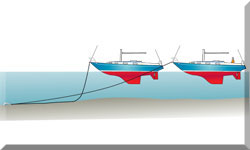
Copyright © 2024 Dick McClary Sailboat-Cruising.com

Boats & Flags: 11 Answers You Should Know (For Beginners)
The flags on a boat can signify many different things.
Mostly, they can seem confusing to a layperson or a new boater.
Flying the wrong flag at the wrong position can confuse other boaters and result in a fine!
Here’s what you need to know about how and when you can use flags on a boat:
Table of Contents

1. What Are The Main Types Of Flags Flown On Boats?
On any non-commercial vessel, you can usually find these four different types of flags:
- Ensign – a variety of national flag
- Burgee – a flag representing a boating organization
- Private Signal – a small custom-made flag for the boat owner
- Courtesy – the flag of a foreign country for an onboard guest or when you are in foreign waters
2. What is an Ensign Flag, and When Do I Use It?
An ensign is a flag from the nation from which the boater originates.
They are slightly different from their national flags. Ensign flags used to be restricted to documented vessels only.
Now it is common courtesy to fly the national flag on all types of recreational boats.
It is proper etiquette to only fly ensign flags from 0800 to sunset unless you’re in a boat race outside those hours. It is also important to take this flag down before leaving your boat if it is unmanned at sunset.
If you take your boat into international waters, you should fly your national flag. These days ensign flags are flown off of the stern.
If you do this, make sure it is on a staff-pole and that the pole is long and angled.
If you offset it to one side (like the starboard side), it’ll fly clear of the engine’s exhaust.
This will also keep it clear from the rigging.

3. What is a Burgee Flag, and When Do I use That?
A burgee flag is a small flag with the skipper’s sailing organization or yacht club on it.
It follows the skipper from boat to boat. These are flown day and night.
Traditionally, sailing vessels hoisted these flags on a “pigstick” at the top of the highest mast. Because of instruments that are often at the top of the mast, it is more common to hoist a burgee on a spreader halyard.
Of course, this is the modern way to fly it.
The starboard rigging is known as a place of honor (when it comes to flags). That’s why you fly the host country’s flag there when visiting a foreign port.
4. What is a Private Signal, and When Do we use Those?
These are small flags that are custom designed (and custom made) specifically for the boat owner.
It’s flown day and night but is only flown when the owner is in command of the boat.
If a different sailor is in command, they are to fly their own private signal.
Private signals are flown at the aftermost mast’s head (if you have a multi-mast boat). On a sloop, fly private signals on starboard rigging, below the burgee.
Unless you don’t have a burgee, then you can fly it alone.
5. What’s a Courtesy Flag, and When Do I Fly That?
Courtesy flags are flown when you are in a foreign nation’s waters.
It also comes into play when you have someone from a foreign country on your vessel.
You can only fly a courtesy flag if certain conditions are met:
- Only after authorities from the country have granted you clearance.
- After you remove your yellow “Q” flag.
- If you have a flag that is in the proper condition.
- If you fly a courtesy flag, do so at the boat’s starboard spreader.
- If there is more than one mast, then it must be flown off the starboard spreader of the forward most mast.
By “proper condition,” you must fly a flag that is not old or in a disrespectful state.
If you do fly a ratty old flag, you could be fined for being disrespectful!
6. What About International Signal Flags?
There is a system of internationally recognized numerical and alphabetical pennants and flags known as the International Code of Signals.
This helps communicate when you’re out in the open water.
The messages these flags send can be about navigation or even safety.
Signals can be sent by:
- Flag semaphore
- Signal lamp (otherwise known as “blinkers”)
- Radiotelephony
- Radiotelegraphy
There are so many different communication methods because it is important when the crew’s safety is concerned—especially when you’re in open water.
Boaters use nautical signal flags in several different ways:
- With each spelling out a letter of a message
- With a flag symbolizing a specific message (For example, an “A flag” is flown by diving support vessels when they can’t move from their current location.)
- In a yacht or dinghy race, with each flag flying as code (For example, a “P flag” is used to stand for “Prepare,” which indicates that the race is about to start.)
Some boaters use signal flags to dress their ships for holidays by hoisting the national ensign at the stern staff first.
A rainbow of flags can then be arranged, reaching from the waterline forward to the aft, from the bowsprit end (or stem).
7. Why are There so Many Boat Flags?
Flags are flown for multiple reasons but remember that when you’re out at sea, this is the easiest way to recognize other boats.
It’s like the license plate on a car. Different countries have different license plates.
Within each country, different states or provinces can also have different license plates.
Then, you can have symbols that signify clubs or organizations on your license plate in each state.
This is a way you can express yourself on your vessel.
Check out our article about what colored flags on houses are all about.
8. Why are Some Flags Flown at Half-Mast?
Just like on land, flags are sometimes flown at half-mast in respect for someone who has passed.
This isn’t required in all places, nor is it mandated by any law.
However, it’s good to note why you might see this when you are out in the water.
Some boaters will also dip their flags (drop it down to half, then raise it again) as a friendly signal to a passing boater.
9. What Size Are Boat Flags?
Generally, boat flags come in different sizes, depending on the type of boat that you have.
For aesthetic purposes, most flags are roughly 1” per foot of the length of your boat.
Also, the staff should be twice the length of the height of your flag.
For example, if you have a powerboat that is 33’ long, you should have flags that are 24” x 36” on a staff that is 48”.
This is the recommended proportion of ensign flags. Burgee and private signals are approximately half that size. For the same powerboat example above, you might get burgee and private signal flags, which are 12” x 18”.
10 What do “Fishing Flags” Mean?
Fishing flags are signal flags that have representations of various types of fish on them.
Flying one (or more, if you’re lucky) lets other boaters know what sort of fish you’ve caught that day. It also lets other boaters know what sort of fish are in the area that day.
Fishing flags should be placed on the port rigger, spaced at least one flag length apart. This will let the proper authorities or other boaters count your catch easily.
It should also be placed in order of size, with the biggest species of fish on top.
Certain rules follow certain types of fish so make sure you read up on the fish flag etiquette in fishing manuals.
In the past, if a fisherman tagged a fish, they would fly the species flag with a white “T” under it to let others know of their tag. If they hoisted the species flags upside down, that signifies that they had caught and released that particular fish.
If they did so with multiple fish of the same species, they hoisted several red triangle pennants under that species flag.
However, today most fishermen are doing the opposite when they practice catch and release. They fly a fish right-side-up to signify that it swam away healthy after being released.
While an upside-down species flag signifies a fish caught and harvested.
11. How Much do Boat Flags Cost?
Boating flags can range from $12 for a single flag to $175 for a set.
The average cost for an ensign flag is roughly $20.
Final Thoughts
There is a long history of nautical flag use.
Using the wrong flag or flying a flag in the wrong position can get you into trouble. Thus, it is important to brush up on the meanings of different flags before using them.
It is important to have a boat handling book or flag manual on your boat in case of emergency. The US Power Squadron is a good source for their publication “ How to Fly Flags, Nautical Flags Display .”
If you are out with your family and an emergency occurs, they must know how to call and signal for help in different ways: including using a flag signal.
Flags aren’t just important for you and your boat, however.
It is also important to recognize what different flags may mean when you run across other boats.
Click to share...

Nautical flags: Meanings and Alphabet
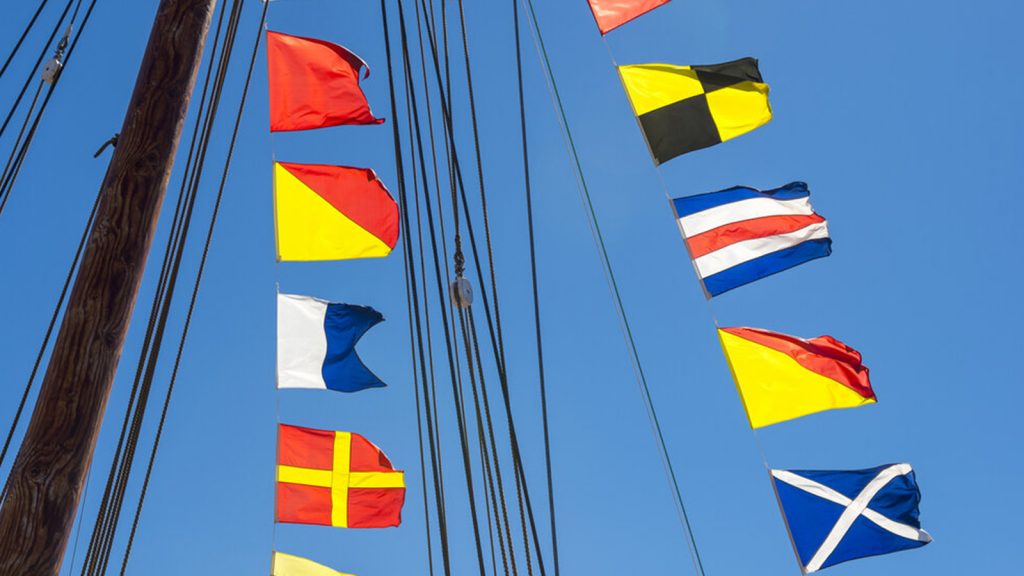
Nautical flags serve the purpose of communication in situations concerning navigation safety and individuals. They form an international code system enabling boats to signal to shore or for two boats to communicate with each other.
Individual flags have specific and standard meanings. These ones can be used in combination with another flag or alone. Using different nautical colored flags have a different meaning.
What are Nautical Flags?
Nautical flags, also known as maritime signal flags, are a set of flags and pennants used to communicate messages between ships and boats. Each flag represents a specific letter, number, or message, allowing vessels to convey information even when verbal communication is not possible.
The use of nautical flags dates back centuries and continues to be an essential aspect of seafaring traditions.
Nautical flags are compose of 26 square flags that represent the letters of the alphabet. There are also 10 numbered pendants, one answering pendant and three substitutes.
You will see nautical flags in a few colors because only a few flag colors are easily recognized:
Nautical Flags and Their Meanings
Importance of nautical flag meanings.
Understanding the meanings behind nautical flags is crucial for anyone involved in maritime activities.
Whether you’re a sailor, a boater, or simply fascinated by the sea, having knowledge of nautical flag communication enables you to interpret messages, navigate safely, and respond appropriately in different situations.
International Code of Signals
The International Code of Signals, also known as ICS, is a special set of rules that tells people who use nautical flags how to use them correctly. It helps sailors understand each other and communicate important messages by using these special flags in a specific way.
It was first established in the 19th century to facilitate communication and prevent misunderstandings among ships of different nationalities.
Over time, the code evolved and expanded to cover a wide range of messages and situations encountered at sea.
Within the International Code of Signals, each nautical flag represents a specific letter or number, as well as a set of predefined messages. These flags are combined to form words, phrases, and sentences, allowing vessels to spell out messages and communicate essential information.
The nautical flags in the International Code of Signals can be categorized into several groups, including alphabetic flags, numeric pennants, substitutes, repeaters, and special flags. Each category serves a specific purpose and carries distinct meanings when used in communication.
Individual Flag Meanings
Numeric pennants and their meanings.
Numeric pennants are a series of flags, each representing a number from zero to nine. These flags are used to communicate numerical information, such as coordinates, distances, or time. By combining different numeric pennants, vessels can convey precise numerical values, ensuring accurate communication between ships.
Letter flags and their meanings
Individual letters of the alphabet are represented by letter flags in the International Code of Signals. They are used to spell words and form sentences. Understanding the meanings assigned to each letter flag is critical for interpreting nautical flag messages and effectively communicating information.
Substitutes and repeaters in nautical flag communication
Substitute flags and repeater flags play important roles in nautical flag communication. Substitute flags are used to replace specific letter flags when they are not available or cannot be easily identified.
Repeater flags, on the other hand, are used to indicate that the preceding flag should be repeated. These flags ensure clarity and facilitate accurate transmission of messages.
Special flags and their purposes
The International Code of Signals includes several special flags that represent specific messages or commands. These flags convey information related to safety, medical assistance, maneuvering instructions, and more.
Understanding the meanings behind these special flags is crucial for maintaining safety and effective communication on the water.
Nautical Flags Meanings
It’s important to understand nautical flags and their meaning because they are valuable at sea in case of breakdowns in other communications systems (eg. radio) or in case of danger.
- One-flag signals are urgent or common signals.
- Two-flag signals are used for distress and maneuvering.
- Three-flag signals are for points of the compass, relative bearings, standard times, verbs, punctuation and also general code and decode signals.
- Four-flags are used mostly for geographical signals, names of ships, bearings, etc.
- Five-flag signals are used to relate time and position.
- Six-flag signals are used to indicate the main cardinal directions (N, S, E or W) in latitude and longitude signals.
- Seven-flags are used as signals for indicating longitude signals containing more than one hundred degrees.
Nautical flags are also used in nautical racing which signal to the competitors what they are supposed to do.
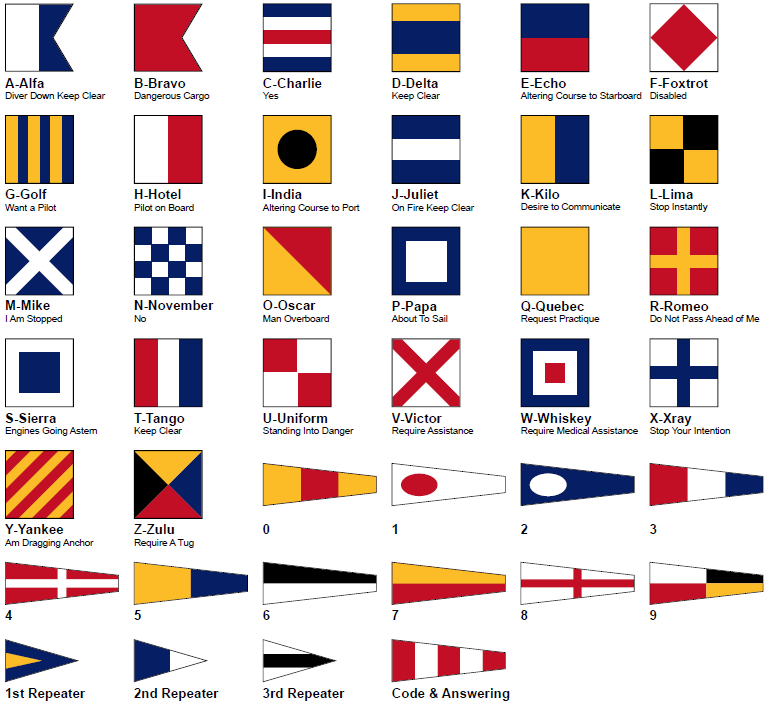
The Nautical Flag Alphabet
It is critical to understand that each flag representing a letter has a specific meaning.
International meanings for nautical flags:
- A: Alpha – diver down; I am undergoing a speed trial
- B: Bravo – carrying dangerous cargo
- C: Charlie – yes (affirmative)
- D: Delta – keep clear of me, I am manoevering with difficulty
- E: Echo – altering course to starboard
- F: Foxtrot – I am disabled, communicate with me
- G: Golf – I want a pilot
- H: Hotel – a pilot on board
- I: India – I am altering my course to port
- J: Juliet – vessel on fire keep clear
- K: Kilo – I want to communicate with you
- L: Lima – stop your vessel instantly, I have something important to communicate; Come Within Hail or Follow Me (Sailing Regatta)
- M: Mike – my vessel is stopped and making no way through the water; Mark Missing (Sailing Regatta)
- N: November – no (negative); Abandonment and Re-sail (Sailing Regatta)
- O: Oscar – Man overboard
- P: Papa – In port: All personnel return to ship; vessel is about to sail; At sea, fishing vessels might use this specific flag to convey the message “My nets have become entangled with an obstacle.”
- Q: Quebec – I request free pratique
- R: Romeo – reverse course
- S: Sierra – engines are going astern
- T: Tango – Keep clear; engaged in trawling. (International); Do not pass ahead of me. (Navy)
- U: Uniform – you are heading into danger
- V: Victor – require assistance
- W: Whiskey – require medical assistance
- X: X-ray – stop your intention
- Y: Yankee – am dragging anchor
- Z: Zulu – I require a tug
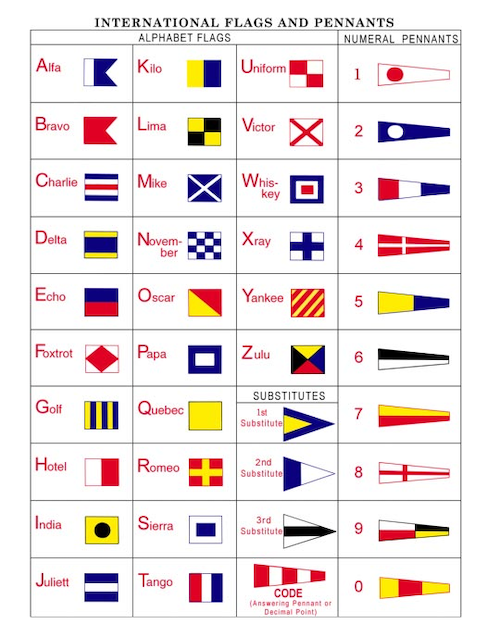
Solo or combined nautical flags have different meanings
Depending on the type of message, boats fly between 1 and 7 nautical flags. The combination of the O (Oscar) and W (Whiskey) flags, meanwhile, means “Man overboard. I require medical assistance”.
Signals with two nautical flags usually mean a certain problem of danger or maneuver. Three or more flags may include pendants and may indicate things such as compass points, time and position, geographic signals, geographic coordinates, and boat names.
Nautical Flags, sometimes the secret language of ships
While sailors around the world use nautical flags to communicate different scenarios, certain situations use secret language.
For example, the US Navy groups signals together in ways known only to its staff to communicate with its fellow ships.
NATO uses also the same nautical flags, with a few additional ones to warships, alone or in short sets to communicate various unclassified messages.
In yacht racing, the nautical flags have other meanings. These ones are solo or combined.
The P flag, for example, is employed as the “preparatory” flag to indicate an impending start, while the S flag indicates that a course has been shortened.
Nautical Flags to Buy
Interested in buying nautical flags to decorate your yacht? Whether you want to add a nautical flag pole, or you’re looking to replace an old nautical flag, we hope you find what you’re looking for!
Set of 50 Nautical Flags
We recommend this set of 50 (100% cotton) nautical flags. All flags are hand-made, so they can be quite smaller or bigger. Each flag is about 8 inches tall and 13 inches wide. All are printed on both sides. They give you a guarantee on color for life.
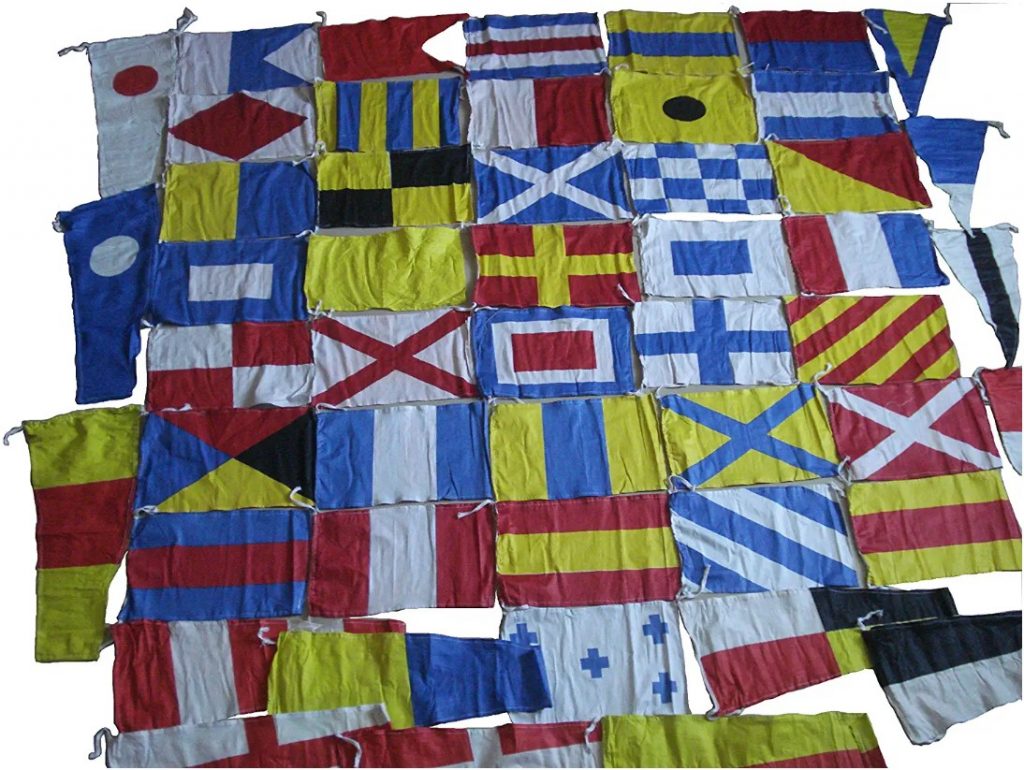
Maritime Signal Flags - 40 Different Decorative Flags - Over 40 Feet Long - Easy to Display
The flags are constructed of weather-resistant nylon cloth with double stitched seams. They are connected on a nylon chain with knots at both ends for convenient hanging.
These rectangular flags are 6″ x 9″, while pennant flags measure 6″ x 14″ or 6″ x 9″. The nylon cable is more than 40 feet long, with 7″ between flags and 36″ ties on either end.
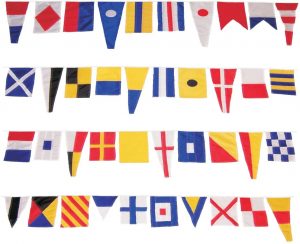
FLAGLINK International Marine Navy Signal Code Flag Set - String of 40 Flag - 40 Feet Long – Nautical Maritime Boat Ship Vessel Nautical Theme Decoration for Patry
Do you plan on throwing a big party on the boat and want to deck out the entire vessel in honor of the occasion? These nautical flags, which are less expensive than the previous ones, are an excellent choice for interior or outdoor decorations.
You may hang your ornamental flags in your front yard, garden, or patio, so that your family and friends can view the gorgeous holiday flag design from every aspect and vantage point. Because they are constructed of a water-resistant polyester fabric, they may be left outside for an extended period of time.
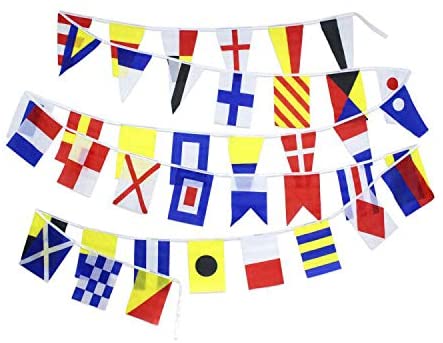
What nautical flags mean?
The purpose of nautical flags is to give ways and means of communication in circumstances involving the safety of navigation and people. Nautical flags are an international coding system used for a boat to indicate to land or for two vessels to signal to each other in situations involving the safety of navigation and people.
How many nautical flags are there?
There are 26 square nautical flags. Each of them symbolizes an international code term associated with the letters of the alphabet, such as Alpha, Bravo, Charlie, Delta, and so on.
What are nautical flags called?
Nautical flags are also known as international maritime signal flags, signal flags or boat flags.
How do you spell out messages using nautical flags?
Messages are spelled out using nautical flags by hoisting the flags in the correct sequence according to the International Code of Signals. Each flag represents a letter, and the combination of flags creates words, phrases, and sentences.
Are there any alternative systems to nautical flag communication?
While nautical flags are widely used for communication at sea, alternative systems such as radio communication, semaphore flags, and modern technologies like VHF radios and satellite communications also play a role in maritime communication.
Where can I learn more about nautical flag meanings?
To learn more about nautical flag meanings and communication, you can refer to resources such as official publications on the International Code of Signals, maritime museums, boating and sailing organizations, and online references that provide detailed information on nautical flags and their meanings.
Leave a Comment Cancel Reply
Your email address will not be published. Required fields are marked *

Visual Distress Signals
The regulations.
This information is directed primarily to recreational boaters, but the requirements discussed also apply to operators of vessels engaged in the carrying of six or fewer passengers. The Visual Distress Signal requirements for most commercial vessels are in Title 46 of the Code of Federal Regulations. The requirement to carry visual distress signals became effective on January 1, 1981. This regulation requires all boats when used on coastal waters, which includes the Great Lakes, the territorial seas and those waters directly connected to the Great Lakes and the territorial seas, up to a point where the waters are less than two miles wide, and boats owned in the United States when operating on the high seas to be equipped with visual distress signals.
The only exceptions are during daytime (sunrise to sunset) for:
- Recreational boats less than 16 feet in length
- Boats participating in organized events such as races, regattas or marine parades
- Open sailboats not equipped with propulsion machinery and less than 26 feet in length
- Manually propelled boats
These boats only need to carry night signals when used on these waters at night.
Types of Visual Distress Signals
A wide variety of signaling devices, both pyrotechnic and non-pyrotechnic, can be carried to meet the requirements of the regulation.
- Recreational boats less than 16' operating in coastal waters need only carry night signaling devices when operated at night. All other boats must carry both night and day signaling devices.
- Any combination can be carried as long as they add up to three signals for day use and three signals for night use. Three day/ night signaling devices meet both requirements.
Note: If pyrotechnic devices are selected, a minimum of three must be carried. Pyrotechnic devices come with an expiration date, which is 42 months from the date of manufacture. To meet carriage requirements, you must have at least three un-expired flares aboard. You may carry expired flares as back up, but they will not count towards the legal requirement.
The following details a combination of devices which can be carried in order to meet the requirements:
- Three hand-held red flares (day and night). Flares must be under 42 months of age.
- One electric distress light (night only).
- One hand-held red flare and two parachute flares (day and night). One hand-held orange smoke signal, two floating orange smoke signals (day) and one electric distress light (night only). Flares must be under 42 months of age.
Pyrotechnic Visual Distress Signaling Devices
Must be Coast Guard approved, in serviceable condition and stowed to be readily accessible. If they are marked with a date showing the serviceable life, this date must not have passed. Launchers produced before Jan. 1, 1981, intended for use with approved signals are not required to be Coast Guard Approved.
USCG Approved Pyrotechnic Visual Distress Signals and Associated Devices include:
- Pyrotechnic red flares, hand held or aerial
- Pyrotechnic orange smoke, hand held or floating
- Launchers for aerial red meteors or parachute flares
The purpose of the regulation is to assure that boaters have a way of attracting attention and securing assistance should the need arise. Properly used visual distress signals will also help reduce the time it takes to locate a boat in difficulty when a search is underway. This will reduce the possibility of a minor emergency becoming a tragedy.
Non-pyrotechnic Visual Distress Signaling Devices
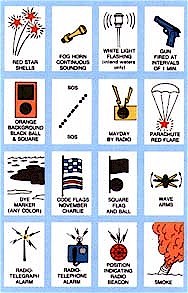
Must carry the manufacturer's certification that they meet Coast Guard requirements. They must be in serviceable condition and stowed to be readily accessible. This group includes:
- Orange distress flag
- Electric distress light
No single signaling device is ideal under all conditions and for all purposes. Consideration should therefore be given to carrying several types. For example, an aerial flare can be seen over a long distance on a clear night, but for closer work, a hand-held flare may be more useful.
SOS Distress Light
The SOS Distress Light is an LED Visual Distress Signal Device that meets U.S. Coast Guard requirements to completely replace traditional pyrotechnic flares. Unlike traditional flares, this electronic flare never expires, which solves the challenge of flare disposal. The LED light flashes up to 60 hours, unlike traditional flares that last minutes or less. It flashes only the SOS sequence, per USCG requirements, and is visible up to 10 nautical miles.
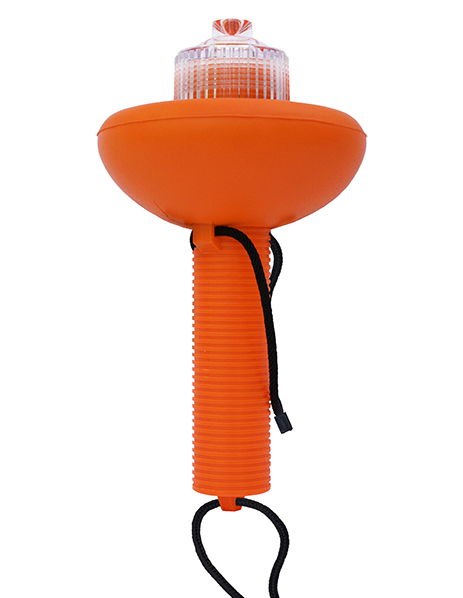
Day Use Only
Hand held orange smoke distress signals.
Hand held distress signals are very common. Make sure to hold the flare with a glove, and make sure to keep the smoke down-wind of your boat.

Floating Orange Smoke Distress Signals
These come in two varieties, one lasting approximately 5 minutes, one lasting 15 minutes.

Orange Distress Signal Flag for Boats
The distress flag must be at least 3 x 3 feet with a black square and ball on an orange background. It is accepted as a day signal only and is especially effective in bright sunlight. The flag is most distinctive when waved on something such as a paddle or a boat hook or flown from a mast.
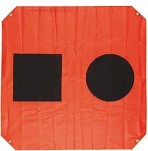
Sea-marker Dye
This is useful when air search has been initiated. Comes in several colors, and should be used when chances of being spotted are high.
Signal Mirror
Although not recognized by USCG as a carriage requirement, a well-handled signal mirror can be very effective in calling attention to oneself. It is low in cost and has an unlimited shelf life.
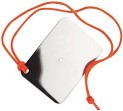
Night Use Only
Electric distress light for boats.
The electric distress light is accepted for night use only and must automatically flash the international SOS distress signal, which is three short flashes, three long flashes, and three short flashes. Flashed four to six times each minute, this is an unmistakable distress signal, well known to most boaters. The device can be checked any time for serviceability if shielded from view.
NOTE: An ordinary flashlight is not acceptable since it must be manually flashed and does not normally produce enough candle power. The Regulation States: "No person in-a boat shall display a visual distress signal on water to which this subpart applies under any circumstances except a situation where assistance is needed because of immediate or potential danger to the persons aboard."
Day and Night Use
- Hand Held Flare Distress Signal
- Parachute Red Flare Distress Signals - (25 mm or larger) These signals require use in combination with a suitable launching device.
- Hand Held Rocket-Propelled Parachute Red Flare Distress Signals
- Distress Signal for Boats, Red Aerial
- Pyrotechnic Flare - These devices may be either meteor or parachute assisted type. Some of these signals may require use in combination with a suitable launching device.
In some states the pistol launcher for meteors and parachute flares may be considered a firearm. Therefore, check with your state authorities before acquiring such launcher.
Visual Distress Signals: When and How to Use Them
Visual distress signals are part of your boat's safety equipment. Check them before you leave harbor. Their intended purpose is to summon help should the need arise. Visual distress signals can only be effective when someone is in a position to see them. Therefore, when employing pyrotechnic devices, do so only when you see or hear a boat or airplane or you are reasonably sure that someone on shore is in position to see your signal and take action. Good judgment is an essential part of successful use of visual distress signals.
All distress signaling devices have both advantages and disadvantages. The most popular, because of cost, are probably the smaller pyrotechnic devices. Pyrotechnics make excellent distress signals, universally recognized as such, but they have the drawback that they can be used only once. Additionally, there is a potential for both injury and property damage if not properly handled.
Pyrotechnics devices have a very hot flame, and the ash and slag can cause burns and ignite material that burns easily. Projected devices, such as pistol launched and hand-held parachute flares and meteors, have many of the same characteristics of a firearm and must be handled with the same caution and respect.
The hand-held and the floating orange smoke signaling devices are excellent (if not the best) day signals, especially on clear days. Both signals are most effective with light to moderate winds because higher winds tend to keep the smoke close to the water and disperse it which makes it hard to see.
Red hand-held flares can be used by day, but are most effective at night or in restricted visibility such as fog or haze. Only Coast Guard or SOLAS flares are acceptable for use on recreational boats. When selecting such flares look for the Coast Guard approval number and date of manufacture. Make sure that the device does not carry the marking: "Not approved for use on recreational boats," and that no more than 3 years have passed since manufacture.
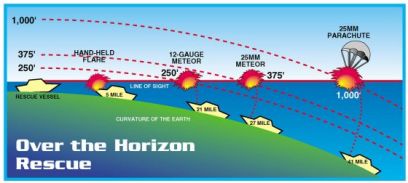
If you See a Visual Distress Signal in the Distance
The unwritten law of the sea requires that a mariner come to the aid of a mariner in distress. Therefore, should you see a distress signal, immediate and positive action should be taken. Notify the nearest Coast Guard station or State authority by radio. Channel 9 on CB and Channel 16 on VHF marine radio (156.8 MHz) are recognized distress channels. If you can assist the stricken vessel without endangering yourself, you should. The Federal Boat Safety Act of 1971 contains a "Good Samaritan" clause stating: "Any person ....who gratuitously and in good faith renders assistance at the scene of a vessel collision, accident, or other casualty without objection of any person assisted, shall not be held liable for any act or omission in providing or arranging salvage, towage, medical treatment, or other assistance where the assisting person acts as an ordinary, reasonably prudent man or woman would have acted under the same or similar circumstances."
Flags serve a variety of purposes in the marine environment. There is no legislation governing the flying of any flag on numbered, undocumented or licensed vessels. However, there is a proper etiquette involved when displaying flags.
Recreational boaters may fly flags to display boating affiliations. For example, many yacht clubs provide triangular shaped burgees to members. And, members of the U.S. Power Squadrons and U.S. Coast Guard Auxiliary fly flags to identify themselves. Boaters also fly flags to identify their home state or nationality.
Flags are also used for specific boating activities and navigational purposes. For example, boats with scuba divers must fly a "diver down" flag when divers are in the water. There are two types of diver down flags and both are appropriate to display. They are a red flag with a white diagonal stripe and a rigid replica of an "alfa" flag.
Another example is the flags used by committee members and participants of events sponsored by the US Sailing, the governing body of sailboat racing.
Flags are also used to signal your need for help. When in distress, a boat should fly an orange flag with a black square and black ball. A man overboard flag, consisting of the letter "O", can be fixed to a staff which is in turn fixed to a life ring.

Dangerous cargo

Altering to starboard

Want a pilot

Pilot on board

Altering to port

Desire to communicate

Stop immediately

I am stopped

Man overboard

About to sail

Request clearance into port (int'l)

Preparing to replenish (at sea)

Engines going astern

Keep clear of me

You are running into danger

I require assistance

Need medical assistance

Watch for my signals

Dragging anchor

Require tug
- – FlagMagic
- – Pirate Flags & History
- – Boat Flag Facts & Info
- – Pride Flags & History
- – Pride Month 2022
Boat Flag Color Meanings
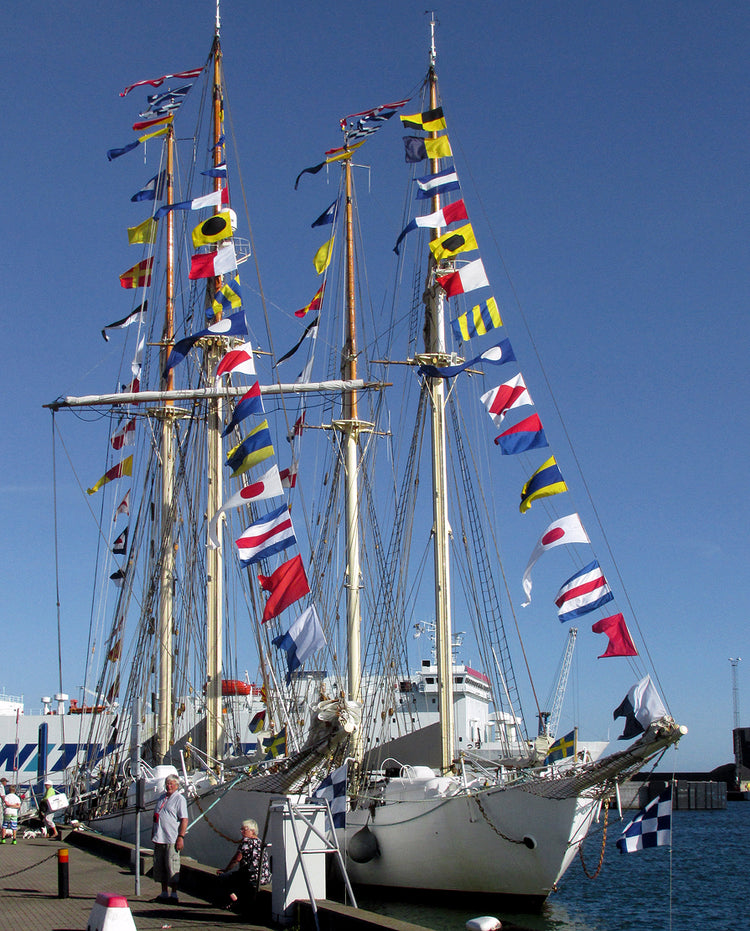
Boat Flag History
Boats have flown flags as a way of communicating across the water from the beginning. Colors designating origin and intent go back into prehistory. However, the modern way of signaling started in the 17th century. The Duke of York is credited with Modern naval code signaling starting with the Lord High Admiral after the Restoration.
To the untrained eye the flags have little meaning besides perhaps the country flags flown. This is not the case though, the colors have very specific meanings that can be seen below.
Once you have learned about what colors mean, check out our collection of boat flags here!
Signal Flags
Signal flags are known as the International Code of Signals.
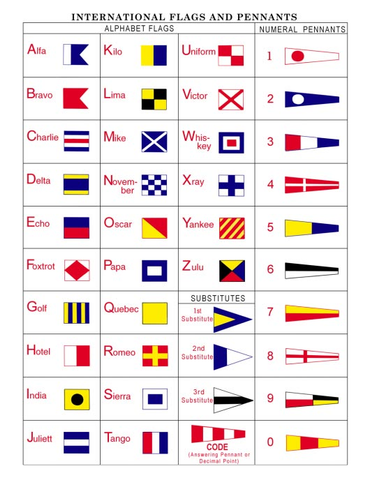
Alfa: Diver Down/Keep clear
Bravo: Dangerous cargo
Charlie: Yes/Affirmative
Delta: Keep clear
Echo: Altering course to starboard
Foxtrot: Disabled
Golf: I need a pilot or I am hauling nets
Hotel: I have a pilot on board
India: Altering course to port
Juliet: On fire
Kilo: I would like to communicate with you
Lima: Stop now
Mike: I am stopped and not making headway
November: No/Negative
Oscar: Man overboard
Papa: Report on board, vessel is about to sail
Quebec: Vessel is healthy, request clearance into port (for international entrance)
Romeo: Do not pass ahead of me
Sierra: Engine going astern
Tango: Keep clear
Uniform: You are running into danger
Victor: I need assistance
Whiskey: I need medical assistance
Xray: Stop and watch for my signal
Yankee: Dragging my anchor
Zulu: I need a tug
Popular Boat Flag Color Questions
Question: What are the colors of nautical flags?
Answer: You can use all colors on nautical flags. There are different kinds of nautical flags with different requirements. For signal flags, white, red, yellow, black, and blue are the only colors allowed.
Question: What d oes a black and yellow flag mean on a boat?
Answer: A black and yellow squares flag is "Lima." In days past it was meant to signal a quarantine with a dangerous infectious disease on board. That standard was abolished in 1965. Now it simply means "you should stop your vessel immediately." Some people may still adhere to the old standard. In either case, you should avoid any ship flying a black and yellow squares flag.
Question: What does a black flag mean on a ship?
Answer: In years past a black flag was flown by pirates. It showed intent to board a vessel and take valuables. If the boarded vessel did not fight back the crew would be spared. You can create your own black pirate flag here! This is in contrast to the red flag which meant no quarter would be given. These days, the black flag is mainly used in sailing races. If a black flag is raised the vessel has been disqualified from the race.
Question: What does a Blue Flag mean on a boat?
Answer: Blue and white means a diver is in the water. Blue not on signal flags shows a regard for the environment. You could create your own custom blue boating flag the show your support of the environment here.
Question: What does a red flag mean on a boat?
Answer: Red is generally a signal of danger. A red flag with black square signals a hurricane or storm. In the Golden Age of Piracy it was a sign that no quarter will be given.
Question: What does a solid orange flag mean?
Answer: In the United States, boats towing people are required to carry a solid orange flag. The flag will be raised with the water skier, tuber, or person otherwise being towed is down and in the water.
Question: What does a white and blue flag mean for boating?
Answer: A white and blue flag is most commonly "Alpha." It signals there is a diver in the water and that other vessels should stay away and steer clear.
Question: What does a white flag mean on a boat?
Answer: A white flag designates a private or dangerous area. It signals "Do not enter, touch, or use."
Question: What does a yellow flag on a yacht mean?
Answer: The yellow flag is "Q" and it signals that there is no disease on board the vessel.
Custom Flag Designers Online
We're creating new, high quality custom flag designers online every day
- What flags to fly and where to put them on your boat
For many a recreational sailor, the same questions come to mind every year. Where should I place the flag? And how big should it be? Can I fly the national flag? At sea you’ll often come across a less experienced crew, who seem to have fully-dressed the boat, having decorated it with flags like a Christmas tree. So let's clear up the issue. It never hurts to go over the basic principles, which are actually very simple. So where does which flag belong and what do they mean?
The place at the stern of a yacht is reserved exclusively for one thing:
The Ensign (the national flag of the country under which the boat is registered)
This is the most important flag, which says the most about the boat and crew. This is because ships have the nationality of the state whose flag they fly under (this right is granted by the state together with the issuing of the relevant documents). Ships are then subject to the exclusive jurisdiction of that state on the high seas (which, of course, results in a number of interesting situations). Please note that on coastal seas, the law of the state whose waters you pass through also applies to the vessel.
Where is it flown?
At the stern, ideally on the flagpole (pushpit) or on the stern forestay (flying the flag depends on whether the ship is sailing or mooring). And it must be the largest flag on the ship
This flag should be flown in the correct manner from sunrise to sunset. It must always be hoisted first and lowered last. No other flag may be flown unless the national flag (ensign) is also flown.
How big should the flag be? According to the decree, the flag (if it is the ensign of a boat) should, for example, have a size of 0.75 x 0.50 m (on a recreational yacht).
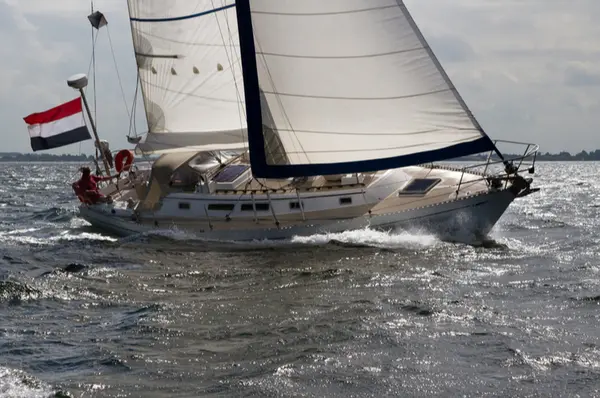
Don't overlook other useful tips:
The starboard spreader.
The starboard spreader is reserved for courtesy flags. They are flown immediately after the ensign and lowered last before it. What flags should they commonly be?
The flag of the state in whose waters you are sailing
It is placed under the starboard spreader and it isn’t just a courtesy to do so, it is a duty.
However, if you are sailing in Croatia on a Croatian ship, there is no need to fly a courtesy flag.
Boat owner’s flag
The yacht owner can also fly their own national flag on the boat. It can be placed on the starboard spreader, but if the owner deems it appropriate it can be flown on the port side, as it is a flag of lower importance (than the ensign).
The spreader is a mast reinforcement (between the mast and the shroud). It is placed on the mast perpendicular to the longitudinal axis of the ship (or points slightly to the stern) and is at right angles to the mast.
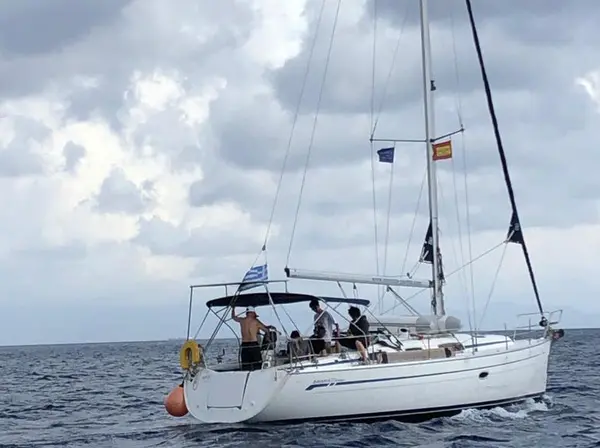
The Port Spreader
All other flags are flown under the port spreader. So what are the other flags you can fly on the yacht?
Signal flags
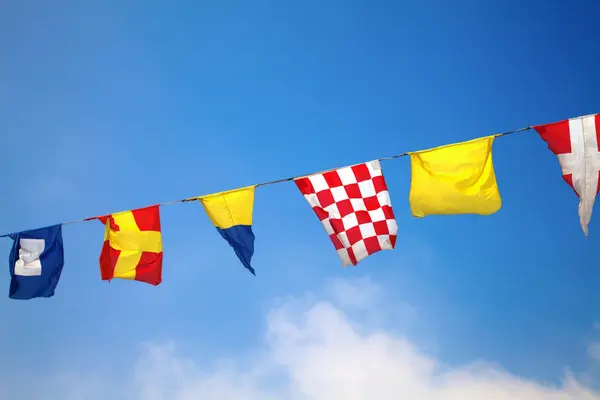
Your national flag
Yes, right here is the place for your own national flag when sailing in Croatia on a Croatian boat.
A burgee is a flag bearing the colours or emblem of a sailing club and should be flown from the main masthead. If this isn’t feasible it should be below the port spreader.
Flags of the nationalities of the crew members
Flags of the countries you’ve visited during the voyage, etc..
How large can the other flags be? They should always be smaller than the ensign.
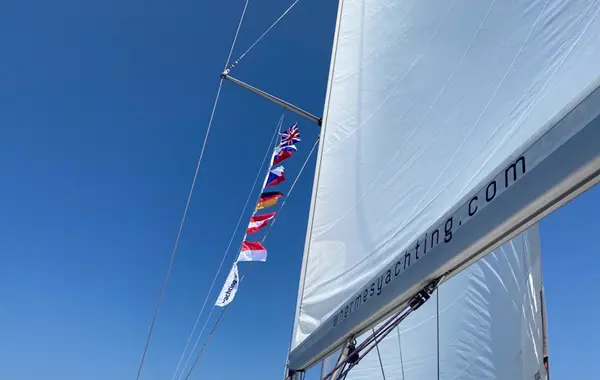
Special flags and occasions
Can i fly a pirate flag .
The international agreement UNCLOS (United Nations Convention on the Law of the Sea) speaks for itself. Stateless ships, ships flying a foreign flag and ships refusing to fly their ensign may be detained and inspected by warships or civil service ships, even on the high seas.
So if you are flying under a pirate flag out of ignorance or innate rebellion :) (i.e. you hang it on the place where the ensign belongs) you definitely risk an interesting experience. But also be careful not to hang in less risky places, for example, where the burgee should be as there are places and ports where you could get a pretty hefty fine.

How to greet other boats with the flag?
A sharp shot from a cannon is a thing of the past. When ships meet, instead of a verbal greeting you dip the ensign. And after the same response from the other boat it can be raised again. But who greets who first? A merchant ship is first when meeting a warship, a smaller vessel of the same flag when greeting a larger one and when two merchant ships of the same type meet, it is the one with the more junior commanding officer.
When ships meet on the high seas, it is customary to add a port salute. Dipping the flag is accompanied by three prolonged blasts of the horn and the same response is acknowledged with one short blast.
Do you know what dressing the ship is?
Dressing the ship consists of flying national flags on top of the masts and stringing signal flags over the tops of the masts to connect the bow and stern.
When is dressing done? It is a sign of celebration and is done on national holidays. However it can it can be done in a lesser way at the order of the ship's captain on special occasions. The national flags are again placed on the tops of the masts accompanied by flying at least four signal flags from both ends of the mast boom.
Would you also like to set sail and enjoy an adventure at sea? Whether you want to sail under the Croatian, Italian or Greek flags, you’ll find everything you need with us.
Our sailboat offer:
Contact us to get the best deal.

Denisa Nguyenová
Practical Boat Owner
- Digital edition

Boat flag etiquette: Everything you need to know about ensigns and burgees
- Andy Du Port
- April 20, 2022
Andy Du Port draws upon 50 years’ experience to share the customary way of doing things when it comes to boat flag etiquette…

Illustration by Jake Kavanagh
Almost everything we do, ashore and afloat, is governed by laws, which we must obey, and guidance, which we can accept or ignore.
When driving, we are governed by the Road Traffic Regulation Act and guided by The Highway Code.
At sea, we are bound by the Merchant Shipping Act and guided by advice from the likes of the Royal Yachting Association (RYA).
For example, the law requires us to wear our national ensign on specified occasions, but we are only advised to hoist it at 0800 and lower it at sunset.
And then we have etiquette, which may be somewhat perplexing but soon becomes second nature.
Article continues below…

Wild swimming and sewage – beware, red flags don’t always mean rough seas
The red flags were flying when I went for a swim at Boscombe Pier. I thought nothing of it. Yes,…

What is an undefaced ensign? And why does it matter? Ask the experts
Tjalling Halbertsma from Bergen, North Holland writes: “I sail a 28ft flat-bottomed Vollenhovense Bol, built in steel and a fine…
It can be specific or it can simply reflect good manners, courtesy and common sense, thus avoiding awkward or embarrassing pitfalls.
Sport-specific
All sports have their etiquette, some of which is quite prescriptive. You only have to google ‘golfing etiquette’ or ‘football etiquette’ to see what I mean.
Sailing etiquette tends to be more relaxed but, nonetheless, you should be aware of it – even if you then decide to ignore it.
The dictionary description is along the lines of: The customary code of polite behaviour among members of a particular group.

Photo: iWebbtravel/Alamy
In other words, in this context, it is ‘what most people do’ when afloat in their boats. To add confusion to this somewhat prickly subject, boat etiquette is continually changing.
When I started sailing yachts in the late 1960s it was de rigueur to conduct Colours and Sunset, with due ceremony, when in harbour.
Many a snooty look would be directed at a yacht who was two minutes late or whose crew was not smartly turned out. Nowadays, the custom has all but disappeared.
Some etiquette is founded on tradition, but most is based on practicalities which, if observed by the majority, just makes life afloat even more agreeable.

Boats under 7m LOA are not allowed to wear special ensigns. Photo: Peter Alvey/Alamy
At one end of the scale you will meet yachtsmen or women who are sticklers for what they regard as inflexible etiquette.
If you don’t conform they will glower at you from under the peaks of their yachting caps and splutter into their gin.
At the other extreme are those who are quite content for their boats to resemble Steptoe’s yard while they themselves ignore all around them. Most fall somewhere in between.
Boat flag etiquette explained
Few topics generate more discussion, irascibility and confusion than boat flag etiquette. As far as I can determine, only one boat flag (the ensign) is governed by the rule of law; if you get it wrong, you could be prosecuted.
The flying of all others is either the subject of well-founded recommendations – usually for safety reasons or to avoid confusion – or simply by what has become common practice.
This is the flag you must get right. Almost every boat which puts to sea wears an ensign. The rules are strict and enforceable under the Merchant Shipping Act: the law requires that only the relevant national ensign may be worn, in the right position.
The law also requires the ensign to be worn on certain specific occasions, such as entering a foreign port or when asked to do so by a warship.
You would be breaking the law by hoisting any boat flag other than a national ensign at the ensign staff or other authorised position.

River Class Will O’ The Wisp with ensign on the Norfolk Broads. Photo: Anglia Images /Alamy
By all means fly regional flags elsewhere in the rigging. It is a nice custom, for example, to fly the Cornish flag in Cornwall or the Breton flag in Brittany – usually at the port spreader.
Should you hoist your ensign in the morning and lower it at night? This is not compulsory and most people now do not.
Theories abound about the origins of Colours and Sunset, the most likely being that all boat flags, not only ensigns, were taken in at night for two very logical reasons: no one could see them, and it saved bunting.
This then developed into the ceremonies of Morning Colours (usually at 0800 in the summer and 0900 in the winter) and Sunset (referred to as Evening Colours when conducted at 2100 if sunset is later).

Traditionally, an ensign is ‘worn’ while all other flags are ‘flown’. Photo: Stuart Pearce/Alamy
I can find no evidence to support the various beliefs that these ceremonies show veneration for those who have lost their lives at sea or that they demonstrate respect for the monarch.
However, etiquette also comes into play. Many yacht clubs conduct Colours and Sunset, and require their members to do so.
So if you find yourself berthed for the night in sight of such a club, or in the company of its members, boat flag etiquette suggests that you should follow their lead.
Similarly, it would be remiss of you not to lower your ensign at the same time as a nearby warship.
Lowering or hoisting the ensign on a short staff is not really practicable, so it is widely accepted that the staff may be removed, with the ensign attached, and stowed for the night.
Avoid wrapping the ensign round the staff and leaving it in situ; it looks scruffy and is neither one thing nor the other.
Most other boat flags demand no such angst, but the burgee comes a close second. If you are entitled to wear a ‘special ensign’ i.e. white, blue (plain or defaced) or red (defaced), your permit will dictate that the relevant burgee must be flown at the same time.
If this applies to you, you will know all about it. If not, don’t worry. Some clubs insist their members fly the burgee at the masthead. Otherwise, the starboard spreader is an acceptable alternative.

A defaced blue ensign
Courtesy flags
Standard practice is to fly a courtesy flag when in the territorial waters of another nation, usually hoisted at the starboard spreader (never at the masthead). Some countries require a courtesy flag to be worn, and you could cause considerable offence if you do not comply.
A tricky situation arises if you normally fly a burgee at the starboard spreader, as a courtesy flag should take precedence. A solution is to transfer the burgee to the port spreader.
If the country you are visiting also requires you to fly a Q flag, your problems just get worse. There doesn’t seem to be much agreement on this but I suggest you should leave the courtesy flag on its own to starboard, and fly the Q flag below the burgee to port.
The situation will resolve itself as soon as you have been cleared by customs and can put the Q flag away.
Other flags
Basically, you can do what you like but common sense indicates that you should not fly any boat flags which could be misinterpreted.
For example, almost all the International Code Flags (A-Z and 0-9) have specific meanings. If you decide to fly flag Juliet because its blue and white stripes match your topsides, you will also be signalling ‘On fire and have dangerous cargo on board; keep well clear of me’.
For much the same reason, there is a recommended order for boat flags when dressing overall. If you follow it, not only will the flags give a pleasing appearance, you can also be sure that you do not unintentionally spell anything which you may regret.
You often see boats flying all sorts of bunting. A common boat flag is the Jolly Roger (also known as the Skull and Crossbones), or those with young children may be seen flying a kite in the form of a fish from the backstay.
Does it matter? Not really, but boat flag etiquette suggests that too many flags is a bit sloppy and makes your boat look like a fairground.
As for burgees (again), I see no reason not to fly more than one (being careful to obey the special ensign rules if relevant), but too many could imply that you are either showing off or indecisive.
You can read more boat flag etiquette guidance on the official Royal Yachting Association website .
Why not subscribe today?
This feature appeared in the May 2022 edition of Practical Boat Owner . For more articles like this, including DIY, money-saving advice, great boat projects, expert tips and ways to improve your boat’s performance, take out a magazine subscription to Britain’s best-selling boating magazine.
Subscribe, or make a gift for someone else, and you’ll always save at least 30% compared to newsstand prices.
See the latest PBO subscription deals on magazinesdirect.com

Boat Flags, Nautical Flags and Marine Flags: Types and Meanings
Olivia benjamin.
- July 24, 2023
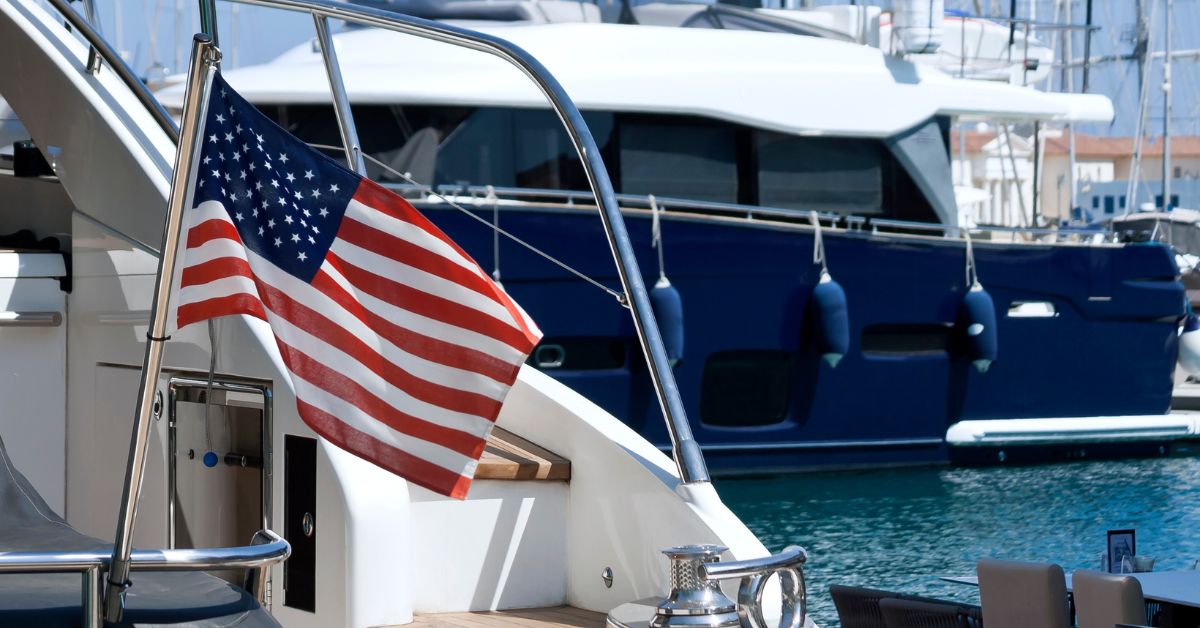
Boat flags are colorful and symbolic signals that serve multiple purposes on boats. The purpose of boat flags is to communicate messages and signals to other boaters, marine authorities, and the general public.
They indicate various important information such as the boat’s nationality, the presence of dangerous cargo, the name of the ship or yacht club, geographical signals, and much more.
Additionally, boat flags are often used as decorative items, contributing to the coastal décor of the boat. They can showcase the personality of the boat’s owner or represent a sailing organization. Boat flags are a great way to personalize your nautical vessel and have some fun along the way.
Types of Boat Flags
1. american flags on boats.
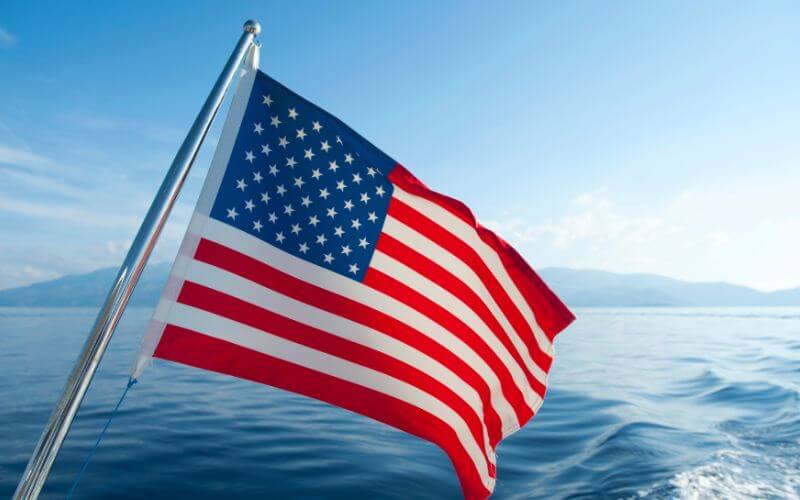
When it comes to displaying national pride and patriotism on the water, American flags are a common sight on boats. Not only does flying the American flag on a boat showcase a love for the country, but it also adheres to maritime customs and traditions.
Whether a small recreational vessel or a large yacht, displaying the US flag allows boat owners to demonstrate their allegiance and honor the values the flag represents.
The U.S. Yacht Ensign is a variation of the American Flag which is used in lieu of the traditional American Flag on yachts that are only traveling with U.S. waters.
History of the American Flag on Boats
The history of the American flag on boats is rooted in the evolution of nautical flags and their significance in communication between ships. As early as the 19th century, flags were used to convey messages and identify ships at sea.
With its iconic red, white, and blue design, the American flag became an important symbol of national pride and patriotism. It was incorporated into the flag communication system , allowing ships to display allegiance and send messages to fellow vessels.
Over the years, regulations and guidelines were established for flying the American flag on boats. These regulations ensure that the flag is displayed with the respect and dignity it deserves. Using the U.S. flag on boats has become standard on military vessels, recreational boats, and yachts.
Regulations for Flying an American Flag on a Boat
When displaying the American flag on a boat, specific regulations and guidelines should be followed to ensure the flag is treated with proper respect and dignity. These regulations help maintain the integrity of this symbol of national pride and patriotism.
Firstly, Flag sizes for boats need to match their size and style. Here are some guidelines:
|
| ||||
| 8×12″ | 12×18″ | – | – | |
| 10×15″ | 12×18″ | 10×15″ | 16×24″ | |
| 10×15″ | 16×24″ | 10×15″ | 16×24″ | |
| 12×18″ | 16×24″ | 12×18″ | 24×36″ | |
| 12×18″ | 24×36″ | 14×21″ | 24×36″ | |
| 14×21″ | 24×36″ | 14×21″ | 24×36″ | |
| 14×21″ | 24×36″ | 16×24″ | 2.5×4′ | |
| 16×24″ | 2.5×4′ | 20×30″ | 2.5×4′ | |
| 16×24″ | 2.5×4′ | 20×30″ | 2.5×4′ | |
| 20×30″ | 2.5×4′ | 20×30″ | 2.5×4′ | |
| 20×30″ | 3×5′ | 24×36″ | 3×5′ | |
| 24×36″ | 3×5′ | 24×36″ | 3×5′ | |
| 24×36″ | 4×6′ | 30×48″ | 4×6′ | |
| 30×48″ | 4×6′ | 30×48″ | 4×6′ | |
The yacht ensign should be the largest flag on the boat regardless if it’s a power boat or a sailboat. All other flags should be smaller.
The positioning of the flag is also essential. It should be flown from a flagpole or staff, positioned either at the bow (front) of the boat or the stern (back) if that is where the boat’s design allows.
Additionally, the flag should be flown from sunrise to sunset. If the flag is to be flown at night, it must be adequately illuminated to remain visible. Illumination can be achieved using lights specifically designed for this purpose.
Lastly, it is crucial to handle and display the flag with respect. It should never touch the water or be allowed to touch the ground. It should be properly folded and stored safely and respectfully when not in use.
2. Substitute Flags
Substitute flags are employed when the national flag is not suitable or available due to adverse weather conditions, damage, or other circumstances. These flags are designed to resemble the national flag in colors and patterns, allowing vessels to represent their country still while navigating the seas.
3. Courtesy Flags
Courtesy flags, on the other hand, serve as a sign of respect and adherence to local customs when sailing in foreign waters. By flying the courtesy flag of the country they are visiting, boaters demonstrate their awareness and willingness to respect the laws and regulations of the host nation.
4. Pirate Flags for Boats
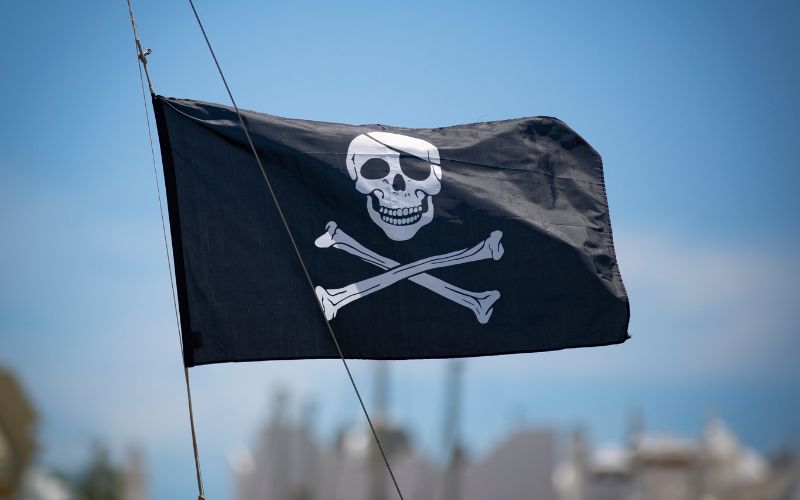
If you want to add adventure and intrigue to your boating experience, consider flying a pirate flag on your boat. Pirate flags, also known as Jolly Roger flags, have long been associated with the swashbuckling world of pirates and have become iconic symbols of adventure on the high seas.
These flags typically feature a skull and crossbones design, meant to strike fear into the hearts of fellow sailors. You can choose from various pirate flag designs, from traditional black and white skulls and crossbones to more colorful and elaborate versions.
History Behind Pirate Flags Flying for Boats
Pirate flags, or Jolly Rogers, emerged during the Golden Age of Piracy in the 17th and 18th centuries. These flags, featuring iconic symbols of pirate lore, were raised to announce the pirates’ arrival and intimidate their victims.
Notable figures like Edward Teach, known as Blackbeard, and Calico Jack Rackham had particularly striking flags. Blackbeard’s displayed a horned skeleton with an hourglass and a stabbed, bleeding heart. Rackham’s flag showed crossed swords under a skull, highlighting his daring nature.
Pirate flags often bore skulls, crossbones, and swords as grave warnings of their intents to loot. A red flag promised a fierce fight, and a black one signified no mercy was forthcoming.
Today, these flags are popular symbols of rebellion and adventure. Their intriguing designs feature in films, literature, and even Halloween costumes, reflecting our enduring fascination with the pirate world.
5. Nautical Flags
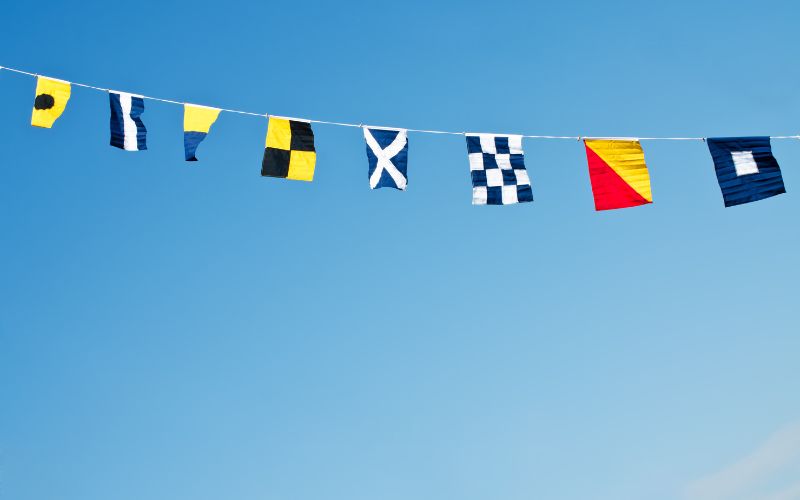
Nautical flags are an essential part of maritime tradition and communication. These brightly colored flags, often flown from boats, yachts, and ships, carry important messages that can be understood by sailors and vessels from afar.
Each flag represents a specific meaning or message, allowing for effective communication between ships, yacht clubs, and recreational boaters. Nautical flags can convey important information regarding dangerous cargo, indicate numeral pennants to represent specific numbers, or display the names of ships and yacht clubs.
The Nautical Alphabet
In the bustling world of maritime operations, effective communication is paramount for the safety and efficiency of vessels. One invaluable tool in this realm is the Nautical Alphabet. A set of visual signals that utilize flags and pennants to convey specific scenarios and requests between ships.
Each alphabet letter is assigned a unique flag or pennant, allowing easy identification and interpretation. For example, the letter “A” is represented by a red and white flag, indicating “Alpha.” This letter flag is hoisted to signal that a vessel has a diver down and caution must be exercised.
Other notable letters include “B” for “Bravo,” represented by a blue and white flag, signaling the presence of dangerous cargo; “C” for “Charlie,” indicated by a blue and yellow pennant, signifying that a vessel needs assistance; and “N” for “November,” a red and yellow pennant used to indicate that a ship is carrying dangerous chemicals.
The Nautical Alphabet is a universal language for sailors, enabling swift and accurate information relay during critical situations. By understanding and adhering to these flags and pennants, maritime personnel can enhance safety, prevent accidents, and facilitate smoother operations.
Solo and Combined Flags
Boats can display between 1 and 7 nautical flags at any given time. The International Code of Signals governs the use of these flags, providing a standardized system for communication at sea. Solo flags, when flown individually, possess their unique meanings.
However, the real power of these International Code Signal flags lies in their combination. By hoisting different flags together, they create a specific message or instruction for other boaters to understand. These combinations can convey requests for assistance, navigational maneuvers, or alerts to potential dangers.
For instance, the “A” flag signifies a vessel’s need for assistance altering its course. While the “R” flag indicates the intention to maneuver reversely. By using these flags appropriately, boats can communicate their intentions, thereby reducing the risk of collisions and maintaining a safe navigation environment.
Nautical Flag Origins and History
Nautical flags have a rich history spanning centuries and are essential to maritime communication. Flags for signaling between ships date back to ancient times when various civilizations utilized visual symbols to convey messages across vast distances.
However, it was in the 19th century that a comprehensive system of nautical flags was established. In 1855, the International Code of Signals was introduced, standardizing the use of flags for communication between vessels. This significant development allowed ships from different nations to understand each other’s signals, enhancing safety and efficiency in maritime operations.
Nautical flags have evolved to meet the changing needs of the shipping industry. Initially, the flags were primarily used to convey important messages, such as distress signals or requests for assistance. Today, they serve multiple purposes, including decoration and identification of boats and yacht clubs.
6. Custom Boat flags
These are a popular option, allowing you to create a unique flag for your boat. You can personalize these flags with designs such as college team logos, military flags, or religious and political-themed flags.
Wrapping Up
Boat flags hold significant meaning and practical importance in the world of boating. From indicating the nationality of a vessel to communicating essential messages and signals, these flags play a crucial role in maintaining safety, promoting camaraderie among boaters, and respecting maritime traditions.
The vast array of boat flag designs and their unique symbolism makes for an exciting and visually appealing aspect of the boating experience. Moreover, not only professionals and seasoned sailors are limited to boat flags. It is an inclusive practice that welcomes and educates novices, fostering a sense of community on the water.
So, whether you’re a seasoned sailor or a recreational boater, getting a flag for your boat can help enhance your boating experience, showcase your identity, and contribute to the rich history and traditions of the maritime world.
- Van Isle Marina
A Guide to Naming Your Boat: Finding the Perfect Name for Your Boat
Naming a boat is an important and personal decision every boat owner must make. Whether you have just purchased a

What is the Steering Wheel on a Ship Called?
The ship steering wheel holds a special place in maritime history, from tales of daring adventures on the high seas
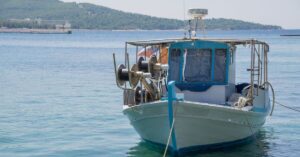
Best Way to Avoid Overloading Your Boat and Keep Your Boat Capacity Under the Weight Limit
Embarking on a boating adventure brings a sense of excitement and freedom. However, ensuring the safety and stability of your
Workshop Insider Newsletter
Be a workshop insider get our latest collection of news and announcements delivered to your inbox..., latest articles.
- June 25, 2024
- Boats , Marine Engineering
- June 24, 2024
Navigating the Darkness: Understanding Boat Navigation Lights and the Different Types
Boat collisions: how to avoid collisions with another boat.
- September 12, 2023
The Ultimate Guide to Pipeliner Welding Hoods: Features, Benefits, Buying Guide, and Best Practices
- Welding Helmets Buying Guides
- September 11, 2023

- Privacy Policy
- Terms of Use
- Affiliate Disclosure
Here's a link you can share with friends and family:
Check out this article from USAA:
Share (Opens Pop-up Layer)


IMAGES
COMMENTS
Calling the O Flag the cheating flag is certainly a bit of a misnomer. The O Flag does, however, suspend Rule 42 of the Racing Rules of Sailing. Rule 42 is particularly notorious, as it bans pumping, rocking, ooching, sculling, and excessive maneuvering, all of which are methods to make your boat go substantially faster.
For the numbers 10 and larger, a boat would combine flags. 3. Colors are by choice. The only colors you'll find on nautical flags are black, blue, red, yellow, and white. These colors stand out quite well when seen with your own eyes on the horizon or through binoculars. Flags can be a solid color or a combination of colors, too. 4.
For example, two red pendants means there's a small-craft advisory. 5. Tally the total. Boats can fly up to seven flags in a row to convey certain messages. Solo flags are the previously mentioned international code words (Alpha for diver down, for instance). Two nautical flags flown together typically indicate distress or a maneuvering ...
International Nautical Flag Meanings. Each flag representing a letter of the alphabet has a meaning. The meanings are as follows: A or Alpha - keep clear, diver down. B or Bravo - carrying dangerous cargo. C or Charlie - yes. D or Delta - keep clear. E or Echo - altering course to starboard. F or Foxtrot - I am disabled.
Protest Flags and Signals. When you see a protest flag in sailboat racing, it's important to understand its meaning. The most common protest flag is a red flag with a white cross, indicating that a boat is protesting another boat for a rule violation. If you find yourself in a protest situation, it's cru ...
ENSIGN- means a flag showing nationality of the boat, i.e. the country where the boat is registered. Ex: The Red Ensign can be flown by a merchant vessel; The White Ensign can be flown by war or naval ships; The Blue Ensign can be flown by public or government vessels; The Civil Ensign is flown by civilian vessels
Flags serve as tools for communication, helping to ensure the well-being of all boaters and promoting a harmonious boating experience. They come in various boating flag colors, each carrying a specific meaning that communicates essential information to boaters:. Red flag: The red flag signifies potential hazards or restrictions.It alerts boaters to exercise caution and be aware of dangers in ...
The Language of the Seas: Unlocking the Mysteries of Sailing Flags. Dive into the vibrant world of sailing flags, where each colour and pattern narrates a story of tradition, safety, and competition. This guide unveils the significance behind the symbols that guide sailors across the globe. The ocean is a vast canvas, painted with the symbols ...
For power boats, all other flags should be 5/8″ long for each foot of overall length. A 56-foot boat should have a 35-inch long flag. Proper boat flag size varies depending on the size of the boat in question. Semaphore flags (discussed below) are always made as an 18″ x 18″ square.
The "N" carries a blue-and-white check pattern, while the "C" flag has blue stripes top and bottom, a red one across the center and two white stripes between each blue and the red stripes. Never signal distress unless you mean it. Other combinations of flags also carry meaning. "C" over "N," the reverse of distress, means "I ...
Because of their dual nature, nautical flags can be hung individually or strung together to send more complex messages. For instance, the delta or "d" flag means "I am maneuvering with difficulty, keep clear.". The victor or "v" flag means "I require assistance.". People who can spot the "d" and "v" flags on sight—a ...
The blue flag is displayed by a boat in distress or requiring assistance, and other boats must immediately make way for the distressed boat. If a boat fails to acknowledge the blue flag signal, it may be subject to penalties. The Red Flag Rule. The red flag rule is used to signal that a race has been stopped due to an emergency situation. The ...
A UK flagged boat (sail or power) must wear the national maritime flag, the Red Ensign, unless entitled to wear a special ensign. Club burgee correctly flown at the masthead The burgee: This is the flag that shows the yacht club or association that you belong to.
Ensign - a variety of national flag. Burgee - a flag representing a boating organization. Private Signal - a small custom-made flag for the boat owner. Courtesy - the flag of a foreign country for an onboard guest or when you are in foreign waters. 2.
Related Article: Boat Flags, ... For instance, an Alpha flag, marked with a red and white diagonal stripe, will be hoisted if a diver is in the water. This alerts other vessels to steer clear of the area. In emergencies, flags like the Oscar Flag, which is orange and yellow, or the Papa flag, designed in blue and white, signal the need for ...
It is critical to understand that each flag representing a letter has a specific meaning. International meanings for nautical flags: A: Alpha - diver down; I am undergoing a speed trial. B: Bravo - carrying dangerous cargo. C: Charlie - yes (affirmative) D: Delta - keep clear of me, I am manoevering with difficulty.
They are a red flag with a white diagonal stripe and a rigid replica of an "alfa" flag. Another example is the flags used by committee members and participants of events sponsored by the US Sailing, the governing body of sailboat racing. Flags are also used to signal your need for help. When in distress, a boat should fly an orange flag with a ...
Two sailing ships dressed overall with their signal flags. International maritime signal flags are various flags used to communicate with ships. The principal system of flags and associated codes is the International Code of Signals. [1] Various navies have flag systems with additional flags and codes, and other flags are used in special uses, or have historical significance.
Boat Flag History. Boats have flown flags as a way of communicating across the water from the beginning. Colors designating origin and intent go back into prehistory. However, the modern way of signaling started in the 17th century. ... Question: What does a red flag mean on a boat? Answer: Red is generally a signal of danger. A red flag with ...
Boat owner's flag. The yacht owner can also fly their own national flag on the boat. It can be placed on the starboard spreader, but if the owner deems it appropriate it can be flown on the port side, as it is a flag of lower importance (than the ensign). The spreader is a mast reinforcement (between the mast and the shroud).
Most other boat flags demand no such angst, but the burgee comes a close second. If you are entitled to wear a 'special ensign' i.e. white, blue (plain or defaced) or red (defaced), your permit will dictate that the relevant burgee must be flown at the same time. If this applies to you, you will know all about it.
Additionally, boat flags are often used as decorative items, contributing to the coastal décor of the boat. They can showcase the personality of the boat's owner or represent a sailing organization. Boat flags are a great way to personalize your nautical vessel and have some fun along the way. Types of Boat Flags 1. American Flags on Boats
How to spot red flags. Information courtesy of USAA. Sept. 5, 2023. 5 to 6 minutes. The joys of boat life can be dampened by a bad deal. Take a look at these red flags to avoid when buying a used boat. It's said that the two best days in a boat owner's life are the day they buy the boat and the day they sell it.